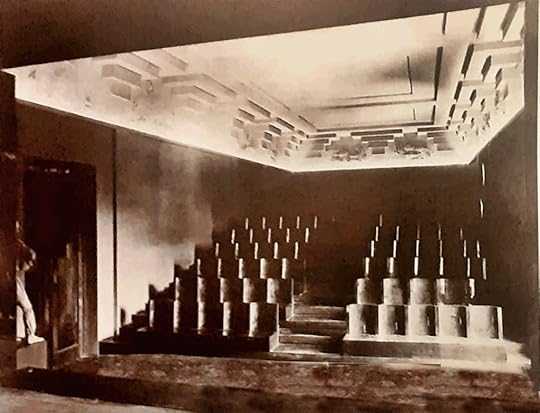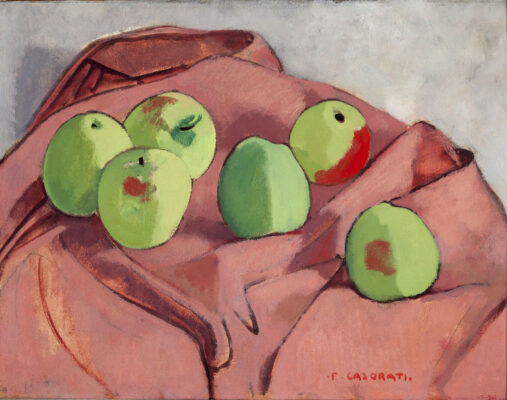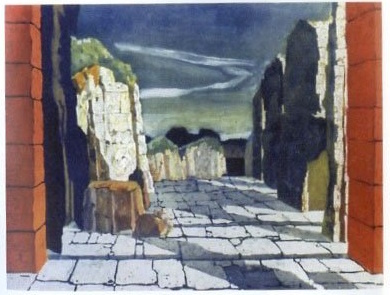Chiara C. Rizzarda's Blog, page 12
May 7, 2025
Werewolves Wednesday: The Wolf-Leader (11)
A werewolf story by Alexandre Dumas père.
Chapter XI: David and GoliathAfter walking the whole length of the village, they stopped before an imposing looking house at the junction of the roads leading to Longpre and Haraniont. As they neared the house the little host, with all the gallantry of a preux chevalier, went on ahead, mounted the flight of five or six steps with an agility which one could not have expected, and, by dint of standing on tip-toe, managed to reach the bell with the tips of his fingers. It should be added, that having once got hold of it, he gave it a pull which unmistakeably announced he return of the master. It was, in short, no ordinary return, but a triumphal one, for the Bailiff was bringing home a guest.
A maid, neatly dressed in her best clothes, opened the door. The Bailiff gave her an order in a low voice, and Thibault, whose adoration of beautiful women did not prevent him from liking a good dinner, gathered that these few whispered words referred to the menu which Perrine was to prepare. Then turning round, his lost addressed Thibault:
“Welcome, my dear guest, to the house of Bailiff Nepomucene Magloire.”
Thibault politely allowed Madame to pass in before him, and was then introduced into the drawing-room.
But the shoemaker now made a slip. Unaccustomed as yet to luxury, the man of the forest was not adroit enough to hide the admiration which he felt on beholding the bailiff’s home. For the first time in his life he found himself in the midst of damask curtains and gilt armchairs; he had not imagined that any one save the King, or at least his Highness the Duke of Orleans, had curtains and armchairs of this magnificence. He was unconscious that all the while Madame Magloire was closely watching him, and that his simple astonishment and delight did not escape her detective eye. However, she appeared now, after mature reflexion, to look with greater favour on the guest whom her husband had imposed upon her, and endeavoured to soften for him the glances of
her dark eyes. But her affability did not go so far as to lead her to comply with the request of Monsieur Magloire, who begged her to add to the flavour and bouquet of the champagne by pouring it out herself for her guest. Notwithstanding the entreaties of her august husband, the Bailiff’s wife refused, and under the pretext of fatigue from her walk, she retired to her own room. Before leaving the room, however, she expressed a hope to Thibault, that, as she owed him some expiation, he would not forget the way to Erneville, ending her speech with a smile which displayed a row of charming teeth. Thibault responded with so much lively pleasure in his voice that it rendered any roughness of speech less noticeable, swearing that he would sooner lose the power to
eat and drink than the remembrance of a lady who was as courteous as she was beautiful.
Madame Magloire gave him a curtsey which would have made her known as the Bailiff’s wife a mile off, and left the room.
She had hardly closed the door behind her, when Monsieur Magloire went through a pirouette in her honour, which though less light, was not less significant than the caper a school-boy executes when once he has got rid of his master.
“Ah! my dear friend,” he said, “now that we are no longer hampered by a woman’s presence, we will have a good go at the wine! Those women, they are delightful at mass or at a ball; but at table, heaven defend me, there is nobody like the men! What do you say, old fellow?”
Perrine now came in to receive her master’s orders as to what wine she was to bring up. But the gay little man was far too fastidious a judge of wines to trust a woman with such a commission as this. Indeed, women never show that reverential respect for certain old bottles which is their due, nor that delicacy of touch with which they love to be handled. He drew Perrine down as if to whisper some thing in her ear; instead of which he gave a good sound kiss to the cheek which was still young and fresh, and which did not blush sufficiently to lead to the belief that the kiss was a novelty to it.
“Well, sir,” said the girl laughing, “What is it?”
“This is it, Perrinette, my love,” said the Bailiff, “that I alone know the good brands, and as they are many in number, you might get lost among them, and so I am going to the cellar myself.” And the good man disappeared trundling off on his little legs, cheerful, alert and fantastic as those Nuremberg toys mounted on a stand, which you wind up with a key, and which, once set going, turn round and round, or go first one way and then the other, till the spring has run down; the only difference being, that this dear little man seemed wound up by the hand of God himself, and gave no sign of ever coming to a standstill.
Thibault was left alone. He rubbed his lands together, congratulating himself on laving chanced upon such a well-to-do house, with such a beautiful wife, and such an amiable husband for host and hostess. Five minutes later the door again opened, and in came the bailiff, with a bottle in either hand, and one under each arm. The two under his arms were bottles of sparkling Sillery, of the first quality, which, not being injured by shaking, were safe to be carried in a horizontal position. The two which he carried in his hands, and which he held with a respectful care which was a pleasure to behold, were, one a bottle of very old Chambertin, the other a bottle of Hermitage.
The supper hour had now come; for it must be remembered, that at the period of which we are. writing, dinner was at mid-day, and supper at six. Moreover, it had already been dark for some time before six o’clock, in this month of January, and whether it be six, or twelve o’clock at night, if one has to eat one’s meal by candle or lamp-light, it always seems to one like supper.
The Bailiff put the bottles tenderly down on the table and rang the bell. Perrinette came in.
“When will the table be ready for us, my pretty?” asked Magloire.
“Whenever Monsieur pleases,” replied Perrine. “I know Monsieur does not like waiting; so I always have everything ready in good time.”
“Go and ask Madame, then, if she is not coming; tell her, Perrine, that we do not wish to sit down without her.”
Perrine left the room.
“We may as well go into the dining-room to wait,” said the little host; “you must be hungry, my dear friend, and when I am hungry, I like to feed my eyes before I feed my stomach.”
“You seem to me to be a fine gourmand, you,” said Thibault.
“Epicure, epicure, not gourmand you must not confuse the two things. I go first, but only in order to show you the way.”
And so saying, Monsieur Magloire led his guest into the dining-room.
“Ah!” he exclaimed gaily as he went in, patting his corporation, “tell me now, do you not think this girl of mine is a capital cook, fit to serve a Cardinal? Just look now at this little supper she has spread for us; quite a simple one, and yet it pleases me more, I am sure, than would have Belshazzar’s feast.”
“On my honour, Bailiff,” said Thibault, “you are right; it is a sight to rejoice one’s heart.” And Thibault’s eyes began to shine like carbuncles.
And yet it was, as the Bailiff described it, quite an unpretentious little supper, but withal so appetising to look upon, that it was quite surprising. At one end of the table was a fine carp, boiled in vinegar and herbs, with the roe served on either side of it on a layer of parsley, dotted about with cut carrots. The opposite end was occupied by a boar-ham, mellow-flavoured, and deliciously reposing on a dish of spinach, which lay like a green islet surrounded by an ocean of gravy.
A delicate game-pie, made of two part ridges only, of which the heads appeared above the upper crust, as if ready to attack one another with their beaks, was placed in the middle of the table; while the intervening spaces were covered with side-dishes holding slices of Aries sausage, pieces of tunny-fish, swimming in beautiful green oil from Provence, anchovies sliced and arranged in all kinds of strange and fantastic patterns on a white and yellow bed of chopped eggs, and pats of butter that could only have been churned that very day. As accessories to these were two or three sorts of cheese, chosen from among those of which the chief quality is to provoke thirst, some Reims biscuits, of delightful crispness, and pears just fit to eat, showing that the master himself had taken the trouble to preserve them, and to turn them about on the store-room shelf.
Thibault was so taken up in the contemplation of this little amateur supper, that he scarcely heard the message which Perrine brought back from her mistress, who sent word that she had a sick-headache, and begged to make her excuses to her guest, with the hope that she might have the pleasure of entertaining him when he next came.
The little man gave visible signs of rejoicing on hearing his wife’s answer, breathed loudly and clapped his hands, exclaiming:
“She has a headache! she has a headache! Come along then, sit down! sit down!” And thereupon, besides the two bottles of old Macon, which had already been respectively placed within reach of the host and guest, as vin ordinaire, between the Hors-d’oeuvres and the dessert plates, he introduced the four other bottles which he had just brought up from the cellar.
Madame Magloire had, I think, acted not unwisely in refusing to sup with these stalwart champions of the table, for such was their hunger and thirst, that half the carp and the two bottles of wine disappeared without a word passing between them except such exclamations as:
“Good fish! isn’t it?”
“Capital!”
“Fine wine! isn’t it?”
“Excellent!”
The carp and the Macon being consumed, they passed on to the game pie and the Chambertin, and now their tongues began to be unloosed, especially the Bailiff’s.
By the time half the game pie, and the first bottle of Chambertin were finished, Thibault knew the history of Nepomucene Magloire; not a very complicated one, it must be confessed.
Monsieur Magloire was son to a church ornament manufacturer who had worked for the chapel belonging to his Highness the Duke of Orleans, the latter, in his religious zeal having a burning desire to obtain pictures by Albano and Titian for the sum of four to five thousand francs.
Chrysostom Magloire had placed his son Nepomucene Magloire, as head-cook with Louis’ son, his Highness the Duke of Orleans. The young man had, from infancy almost, manifested a decided taste for cooking; he had been especially attached to the Castle at Villers-Cotterets, and for thirty years presided over his Highness’s dinners, the latter introducing him to his friends as a thorough artist, and from time to time, sending for him to come up stairs to talk over culinary matters with Marshal Richelieu.
When fifty-five years of age, Magloire found himself so rounded in bulk, that it was only with some difficulty he could get through the narrow doors of the passages and offices. Fearing to be caught some day like the weasel of the fable, he asked permission to resign his post.
The Duke consented, not without regret, but with less regret than he would have felt at any other time, for he had just married Madame de Montesson, and it was only rarely now that he visited his castle at Villers-Cotterets.
His Highness had fine old-fashioned ideas as regards superannuated retainers. He, therefore, sent for Magloire, and asked him how much he had been able to save while in his service. Magloire replied that he was happily able to retire with a competence; the Prince, however, insisted upon knowing the exact amount of his little fortune, and Magloire confessed to an income of nine thousand livres.
“A man who has provided me with such a good table for thirty years,” said the Prince, “should have enough to live well upon himself for the remainder of his life.” And he made up the income to twelve thousand, so that Magloire might have a thousand livres a month to spend. Added to this, he allowed him to choose furniture for the whole of his house from his own old lumber-room; and thence came the damask curtains and gilt armchairs, which, although just a little bit faded and worn, had nevertheless preserved that appearance of grandeur which had made such an impression on Thibault.
By the time the whole of the first partridge was finished, and half the second bottle had been drunk, Thibault knew that Madame Magloire was the host’s fourth wife, a fact which seemed in his own eyes to add a good foot or two to his height.
He had also ascertained that he had married her not for her fortune, but for her beauty, having always had as great a predilection for pretty faces and beautiful statues, as for good wines and appetising victuals, and Monsieur Magloire further stated, with no sign of faltering, that, old as he was, if his wife were to die, he should have no fear in entering on a fifth marriage.
As he now passed from the Chambertin to the Hermitage, which he alternated with the Sillery, Monsieur Magloire began to speak of his wife’s qualities. She was not the personification of docility, no, quite the reverse; she was somewhat opposed to her husband’s admiration for the various wines of France, and did every thing she could, even using physical force, to prevent his too frequent visits to the cellar; while, for one who believed in living without ceremony, she on her part was too fond of dress, too much given to elaborate head-gears, English laces, and such like gewgaws, which women make part of their arsenal; she would gladly have turned the twelve hogsheads of wine, which formed the staple of her husband’s cellar, into lace for her arms, and ribands for her throat, if Monsieur Magloire had been the man to allow this metamorphosis. But, with this exception, there was not a virtue which Suzanne did not possess, and these virtues of hers, if the Bailiff was to be believed, were carried on so perfectly shaped a pair of legs, that, if by any misfortune she were to lose one, it would be quite impossible through out the district to find another that would match the leg that remained. The good man was like a regular whale, blowing out self-satisfaction from all his air-holes, as the former does sea-water. But even before all these hidden perfections of his wife had been revealed to him by the Bailiff, like a modern King Candaules ready to confide in a modern Gyges, her beauty had already made such a deep impression on the shoe-maker, that, as we have seen, he could do nothing but think of it in silence as he walked beside her, and since he had been at tale, he had continued to dream about it, listening to his host, eating the while of course, without answering, as Monsieur Magloire, delighted to have such an accommodating audience, poured forth his tales, linked one to another like a necklace of beads.
But the worthy Bailiff, having made a second excursion to the cellar, and this second excursion having produced, as the saying is, a little knot at the tip of his tongue, he began to be rather less appreciative of the rare quality which was required in his disciples by Pythagons. He, therefore, gave Thibault to understand that he had now said all that he wished to tell him concerning himself and his wife, and that it was Thibault’s turn to give him some information as regards his own circumstances, the amiable little man adding that wishing often to visit him, he wished to know more about him. Thibault felt that it was very necessary to disguise the truth; and accordingly gave himself out as a man living at ease in the country, on the revenues of two farms and of a hundred acres of land, situated near Vertefeuille.
There was, he continued, a splendid warren on these hundred acres, with a wonderful supply of red and fallow deer, boars, partridges, pheasants and hares, of which the bailiff should have some to taste. The bailiff was astonished and delighted. As we have seen, by the menu for his table, he was fond of venison, and he was carried away with joy at the thought of obtaining his game without having recourse to the poachers, and through the channel of this new friendship.
And now, the last drop of the seventh bottle having been scrupulously divided between the two glasses, they decided that it was time to stop.
The rosy champagne prime vintage of Ai, and the last bottle emptied had brought Nepomucene Magloire’s habitual good nature to the level of tender affection. He was charmed with his new friend, who tossed off his bottle in almost as good style as he did himself; he addressed him as his bosom friend, he embraced him, he made him promise that there should be a morrow to their pleasant entertainment; he stood a second time on tiptoe to give him a parting hug as he accompanied him to the door, which Thibault on his part, bending down, received with the best grace in the world.
The church clock of Erneville was striking midnight as the door closed behind the shoemaker. The fumes of the heady wine he had been drinking had begun to give him a feeling of oppression before leaving the house, but it was worse when he got into the open air. He staggered, overcome with giddiness, and went and leant with his back against a wall. What followed next was as vague and mysterious to him as the phantasmagoria of a dream. Above his head, about six or eight feet from the ground, was a window, which, as he moved to lean against the wall, had appeared to him to be lighted, although the light was shaded by double curtains. He had hardly taken up his position against the wall when he thought he heard it open. It was, he imagined, the worthy bailiff, unwilling to part with him without sending him a last farewell, and he tried to step forward so as to do honour to this gracious intention, but his attempt was unavailing. At first he thought he was stuck to the wall like a branch of ivy, but he was soon disabused of this idea. He felt a heavy weight planted first on the right shoulder and then on the left, which made his knees give way so that he slid down the wall as if to seat himself. This manoeuvre on Thibault’s part appeared to be just what the individual who was making use of him as a ladder wished him to
do, for we can no longer hide the fact that the weight so felt was that of a man. As Thibault made his forced genuflexion, the man was also lowered; “That’s right, I’Eveilli! that’s right!” he said, “So!” and with this last word, he jumped to the ground, while overhead was heard the sound of a window being shut.
Thibault had sense enough to understand two things: first, that he was mistaken for someone called L’Eveille, who was probably asleep somewhere about the premises; secondly, that his shoulders had just served some lover as a climbing ladder; both of which things caused Thibault an undefined sense of humiliation.
Accordingly, he seized hold mechanically of some floating piece of stuff which he took to be the lover’s cloak, and, with the persistency of a drunken man, continued to hang on to it.
“What are you doing that for, you scoundrel?” asked a voice, which did not seem altogether unfamiliar to the shoe-maker. “One would think you were afraid of losing me.”
“Most certainly I am afraid of losing you,” replied Thibault, “because I wish to know who it is has the impertinence to use my shoulders for a ladder.”
“Phew!” said the unknown, “it’s not you then, l’Eveille?”
“No, it is not,” replied Thibault.
“Well, whether it is you or not you, I thank you.”
“How, thank you? Ah! I dare say! thank you, indeed! You think the matter is going to rest like that, do you?”
“I had counted upon it being so, certainly.”
“Then you counted without your host.”
“Now, you blackguard, leave go of me! you are drunk!”
“Drunk! What do you mean? We only drank seven bottles between us, and the Bailiff had a good four to his share.”
“Leave go of me, you drunkard, do you hear!”
“Drunkard! you call me a drunkard, a drunkard for having drunk three bottles of wine!”
“I don’t call you a drunkard because you drank three bottles of wine, but because you let yourself get tipsy over those three unfortunate bottles.”
And, with a gesture of commiseration, and trying for the third time to release his cloak, the unknown continued:
“Now then, are you going to let go my cloak or not, you idiot?”
Thibault was at all times touchy as to the way people addressed him, but in his present state of mind his susceptibility amounted to extreme irritation.
“By the devil!” he exclaimed, “let me tell you, my fine sir, that the only idiot here is the man who gives insults in return for the services of which he has made use, and seeing that is so, I do not know what prevents me planting my fist in the middle of your face.”
This menace was scarcely out of his mouth, when, as instantly as a cannon goes off once the flame of the match has touched the powder, the blow with which Thibault had threatened his unknown adversary, came full against his own cheek.
“Take that, you beast” said the voice, which brought back to Thibault certain recollections in connection with the blow he received. “I am a good Jew, you see, and pay you back your money before weighing your coin.”
Thibault’s answer was a blow in the chest; it was well directed, and Thibault felt inwardly pleased with it himself. But it had no more effect on his antagonist than the fillip from a child’s finger would have on an oak tree. It was returned by a second blow of the fist which so far exceeded the former in the force with which it was delivered, that Thibault felt certain if the giant’s strength went on increasing in the same ratio, that a third of the kind would level him with the ground.
But the very violence of his blow brought disaster on Thibault’s unknown assailant. The latter had fallen on to one knee, and so doing, his hand, touching the ground, came in contact with a stone. Rising in fury to his feet again, with the stone in his hand, he flung it at his enemy’s head. The colossal figure uttered a sound like the bellowing of an ox, turned round on himself, and then, like an oak tree cut off by the roots, fell his whole length on the ground, and lay there in sensible.
Not knowing whether he had killed, or only wounded his adversary, Thibault took to his heels and fled, not even turning to look behind him.
…to be continued.
#WerewolvesWednesday: The Wolf-Leader (11)
A werewolf story by Alexandre Dumas père.
Chapter XI: David and GoliathAfter walking the whole length of the village, they stopped before an imposing looking house at the junction of the roads leading to Longpre and Haraniont. As they neared the house the little host, with all the gallantry of a preux chevalier, went on ahead, mounted the flight of five or six steps with an agility which one could not have expected, and, by dint of standing on tip-toe, managed to reach the bell with the tips of his fingers. It should be added, that having once got hold of it, he gave it a pull which unmistakeably announced he return of the master. It was, in short, no ordinary return, but a triumphal one, for the Bailiff was bringing home a guest.
A maid, neatly dressed in her best clothes, opened the door. The Bailiff gave her an order in a low voice, and Thibault, whose adoration of beautiful women did not prevent him from liking a good dinner, gathered that these few whispered words referred to the menu which Perrine was to prepare. Then turning round, his lost addressed Thibault:
“Welcome, my dear guest, to the house of Bailiff Nepomucene Magloire.”
Thibault politely allowed Madame to pass in before him, and was then introduced into the drawing-room.
But the shoemaker now made a slip. Unaccustomed as yet to luxury, the man of the forest was not adroit enough to hide the admiration which he felt on beholding the bailiff’s home. For the first time in his life he found himself in the midst of damask curtains and gilt armchairs; he had not imagined that any one save the King, or at least his Highness the Duke of Orleans, had curtains and armchairs of this magnificence. He was unconscious that all the while Madame Magloire was closely watching him, and that his simple astonishment and delight did not escape her detective eye. However, she appeared now, after mature reflexion, to look with greater favour on the guest whom her husband had imposed upon her, and endeavoured to soften for him the glances of
her dark eyes. But her affability did not go so far as to lead her to comply with the request of Monsieur Magloire, who begged her to add to the flavour and bouquet of the champagne by pouring it out herself for her guest. Notwithstanding the entreaties of her august husband, the Bailiff’s wife refused, and under the pretext of fatigue from her walk, she retired to her own room. Before leaving the room, however, she expressed a hope to Thibault, that, as she owed him some expiation, he would not forget the way to Erneville, ending her speech with a smile which displayed a row of charming teeth. Thibault responded with so much lively pleasure in his voice that it rendered any roughness of speech less noticeable, swearing that he would sooner lose the power to
eat and drink than the remembrance of a lady who was as courteous as she was beautiful.
Madame Magloire gave him a curtsey which would have made her known as the Bailiff’s wife a mile off, and left the room.
She had hardly closed the door behind her, when Monsieur Magloire went through a pirouette in her honour, which though less light, was not less significant than the caper a school-boy executes when once he has got rid of his master.
“Ah! my dear friend,” he said, “now that we are no longer hampered by a woman’s presence, we will have a good go at the wine! Those women, they are delightful at mass or at a ball; but at table, heaven defend me, there is nobody like the men! What do you say, old fellow?”
Perrine now came in to receive her master’s orders as to what wine she was to bring up. But the gay little man was far too fastidious a judge of wines to trust a woman with such a commission as this. Indeed, women never show that reverential respect for certain old bottles which is their due, nor that delicacy of touch with which they love to be handled. He drew Perrine down as if to whisper some thing in her ear; instead of which he gave a good sound kiss to the cheek which was still young and fresh, and which did not blush sufficiently to lead to the belief that the kiss was a novelty to it.
“Well, sir,” said the girl laughing, “What is it?”
“This is it, Perrinette, my love,” said the Bailiff, “that I alone know the good brands, and as they are many in number, you might get lost among them, and so I am going to the cellar myself.” And the good man disappeared trundling off on his little legs, cheerful, alert and fantastic as those Nuremberg toys mounted on a stand, which you wind up with a key, and which, once set going, turn round and round, or go first one way and then the other, till the spring has run down; the only difference being, that this dear little man seemed wound up by the hand of God himself, and gave no sign of ever coming to a standstill.
Thibault was left alone. He rubbed his lands together, congratulating himself on laving chanced upon such a well-to-do house, with such a beautiful wife, and such an amiable husband for host and hostess. Five minutes later the door again opened, and in came the bailiff, with a bottle in either hand, and one under each arm. The two under his arms were bottles of sparkling Sillery, of the first quality, which, not being injured by shaking, were safe to be carried in a horizontal position. The two which he carried in his hands, and which he held with a respectful care which was a pleasure to behold, were, one a bottle of very old Chambertin, the other a bottle of Hermitage.
The supper hour had now come; for it must be remembered, that at the period of which we are. writing, dinner was at mid-day, and supper at six. Moreover, it had already been dark for some time before six o’clock, in this month of January, and whether it be six, or twelve o’clock at night, if one has to eat one’s meal by candle or lamp-light, it always seems to one like supper.
The Bailiff put the bottles tenderly down on the table and rang the bell. Perrinette came in.
“When will the table be ready for us, my pretty?” asked Magloire.
“Whenever Monsieur pleases,” replied Perrine. “I know Monsieur does not like waiting; so I always have everything ready in good time.”
“Go and ask Madame, then, if she is not coming; tell her, Perrine, that we do not wish to sit down without her.”
Perrine left the room.
“We may as well go into the dining-room to wait,” said the little host; “you must be hungry, my dear friend, and when I am hungry, I like to feed my eyes before I feed my stomach.”
“You seem to me to be a fine gourmand, you,” said Thibault.
“Epicure, epicure, not gourmand you must not confuse the two things. I go first, but only in order to show you the way.”
And so saying, Monsieur Magloire led his guest into the dining-room.
“Ah!” he exclaimed gaily as he went in, patting his corporation, “tell me now, do you not think this girl of mine is a capital cook, fit to serve a Cardinal? Just look now at this little supper she has spread for us; quite a simple one, and yet it pleases me more, I am sure, than would have Belshazzar’s feast.”
“On my honour, Bailiff,” said Thibault, “you are right; it is a sight to rejoice one’s heart.” And Thibault’s eyes began to shine like carbuncles.
And yet it was, as the Bailiff described it, quite an unpretentious little supper, but withal so appetising to look upon, that it was quite surprising. At one end of the table was a fine carp, boiled in vinegar and herbs, with the roe served on either side of it on a layer of parsley, dotted about with cut carrots. The opposite end was occupied by a boar-ham, mellow-flavoured, and deliciously reposing on a dish of spinach, which lay like a green islet surrounded by an ocean of gravy.
A delicate game-pie, made of two part ridges only, of which the heads appeared above the upper crust, as if ready to attack one another with their beaks, was placed in the middle of the table; while the intervening spaces were covered with side-dishes holding slices of Aries sausage, pieces of tunny-fish, swimming in beautiful green oil from Provence, anchovies sliced and arranged in all kinds of strange and fantastic patterns on a white and yellow bed of chopped eggs, and pats of butter that could only have been churned that very day. As accessories to these were two or three sorts of cheese, chosen from among those of which the chief quality is to provoke thirst, some Reims biscuits, of delightful crispness, and pears just fit to eat, showing that the master himself had taken the trouble to preserve them, and to turn them about on the store-room shelf.
Thibault was so taken up in the contemplation of this little amateur supper, that he scarcely heard the message which Perrine brought back from her mistress, who sent word that she had a sick-headache, and begged to make her excuses to her guest, with the hope that she might have the pleasure of entertaining him when he next came.
The little man gave visible signs of rejoicing on hearing his wife’s answer, breathed loudly and clapped his hands, exclaiming:
“She has a headache! she has a headache! Come along then, sit down! sit down!” And thereupon, besides the two bottles of old Macon, which had already been respectively placed within reach of the host and guest, as vin ordinaire, between the Hors-d’oeuvres and the dessert plates, he introduced the four other bottles which he had just brought up from the cellar.
Madame Magloire had, I think, acted not unwisely in refusing to sup with these stalwart champions of the table, for such was their hunger and thirst, that half the carp and the two bottles of wine disappeared without a word passing between them except such exclamations as:
“Good fish! isn’t it?”
“Capital!”
“Fine wine! isn’t it?”
“Excellent!”
The carp and the Macon being consumed, they passed on to the game pie and the Chambertin, and now their tongues began to be unloosed, especially the Bailiff’s.
By the time half the game pie, and the first bottle of Chambertin were finished, Thibault knew the history of Nepomucene Magloire; not a very complicated one, it must be confessed.
Monsieur Magloire was son to a church ornament manufacturer who had worked for the chapel belonging to his Highness the Duke of Orleans, the latter, in his religious zeal having a burning desire to obtain pictures by Albano and Titian for the sum of four to five thousand francs.
Chrysostom Magloire had placed his son Nepomucene Magloire, as head-cook with Louis’ son, his Highness the Duke of Orleans. The young man had, from infancy almost, manifested a decided taste for cooking; he had been especially attached to the Castle at Villers-Cotterets, and for thirty years presided over his Highness’s dinners, the latter introducing him to his friends as a thorough artist, and from time to time, sending for him to come up stairs to talk over culinary matters with Marshal Richelieu.
When fifty-five years of age, Magloire found himself so rounded in bulk, that it was only with some difficulty he could get through the narrow doors of the passages and offices. Fearing to be caught some day like the weasel of the fable, he asked permission to resign his post.
The Duke consented, not without regret, but with less regret than he would have felt at any other time, for he had just married Madame de Montesson, and it was only rarely now that he visited his castle at Villers-Cotterets.
His Highness had fine old-fashioned ideas as regards superannuated retainers. He, therefore, sent for Magloire, and asked him how much he had been able to save while in his service. Magloire replied that he was happily able to retire with a competence; the Prince, however, insisted upon knowing the exact amount of his little fortune, and Magloire confessed to an income of nine thousand livres.
“A man who has provided me with such a good table for thirty years,” said the Prince, “should have enough to live well upon himself for the remainder of his life.” And he made up the income to twelve thousand, so that Magloire might have a thousand livres a month to spend. Added to this, he allowed him to choose furniture for the whole of his house from his own old lumber-room; and thence came the damask curtains and gilt armchairs, which, although just a little bit faded and worn, had nevertheless preserved that appearance of grandeur which had made such an impression on Thibault.
By the time the whole of the first partridge was finished, and half the second bottle had been drunk, Thibault knew that Madame Magloire was the host’s fourth wife, a fact which seemed in his own eyes to add a good foot or two to his height.
He had also ascertained that he had married her not for her fortune, but for her beauty, having always had as great a predilection for pretty faces and beautiful statues, as for good wines and appetising victuals, and Monsieur Magloire further stated, with no sign of faltering, that, old as he was, if his wife were to die, he should have no fear in entering on a fifth marriage.
As he now passed from the Chambertin to the Hermitage, which he alternated with the Sillery, Monsieur Magloire began to speak of his wife’s qualities. She was not the personification of docility, no, quite the reverse; she was somewhat opposed to her husband’s admiration for the various wines of France, and did every thing she could, even using physical force, to prevent his too frequent visits to the cellar; while, for one who believed in living without ceremony, she on her part was too fond of dress, too much given to elaborate head-gears, English laces, and such like gewgaws, which women make part of their arsenal; she would gladly have turned the twelve hogsheads of wine, which formed the staple of her husband’s cellar, into lace for her arms, and ribands for her throat, if Monsieur Magloire had been the man to allow this metamorphosis. But, with this exception, there was not a virtue which Suzanne did not possess, and these virtues of hers, if the Bailiff was to be believed, were carried on so perfectly shaped a pair of legs, that, if by any misfortune she were to lose one, it would be quite impossible through out the district to find another that would match the leg that remained. The good man was like a regular whale, blowing out self-satisfaction from all his air-holes, as the former does sea-water. But even before all these hidden perfections of his wife had been revealed to him by the Bailiff, like a modern King Candaules ready to confide in a modern Gyges, her beauty had already made such a deep impression on the shoe-maker, that, as we have seen, he could do nothing but think of it in silence as he walked beside her, and since he had been at tale, he had continued to dream about it, listening to his host, eating the while of course, without answering, as Monsieur Magloire, delighted to have such an accommodating audience, poured forth his tales, linked one to another like a necklace of beads.
But the worthy Bailiff, having made a second excursion to the cellar, and this second excursion having produced, as the saying is, a little knot at the tip of his tongue, he began to be rather less appreciative of the rare quality which was required in his disciples by Pythagons. He, therefore, gave Thibault to understand that he had now said all that he wished to tell him concerning himself and his wife, and that it was Thibault’s turn to give him some information as regards his own circumstances, the amiable little man adding that wishing often to visit him, he wished to know more about him. Thibault felt that it was very necessary to disguise the truth; and accordingly gave himself out as a man living at ease in the country, on the revenues of two farms and of a hundred acres of land, situated near Vertefeuille.
There was, he continued, a splendid warren on these hundred acres, with a wonderful supply of red and fallow deer, boars, partridges, pheasants and hares, of which the bailiff should have some to taste. The bailiff was astonished and delighted. As we have seen, by the menu for his table, he was fond of venison, and he was carried away with joy at the thought of obtaining his game without having recourse to the poachers, and through the channel of this new friendship.
And now, the last drop of the seventh bottle having been scrupulously divided between the two glasses, they decided that it was time to stop.
The rosy champagne prime vintage of Ai, and the last bottle emptied had brought Nepomucene Magloire’s habitual good nature to the level of tender affection. He was charmed with his new friend, who tossed off his bottle in almost as good style as he did himself; he addressed him as his bosom friend, he embraced him, he made him promise that there should be a morrow to their pleasant entertainment; he stood a second time on tiptoe to give him a parting hug as he accompanied him to the door, which Thibault on his part, bending down, received with the best grace in the world.
The church clock of Erneville was striking midnight as the door closed behind the shoemaker. The fumes of the heady wine he had been drinking had begun to give him a feeling of oppression before leaving the house, but it was worse when he got into the open air. He staggered, overcome with giddiness, and went and leant with his back against a wall. What followed next was as vague and mysterious to him as the phantasmagoria of a dream. Above his head, about six or eight feet from the ground, was a window, which, as he moved to lean against the wall, had appeared to him to be lighted, although the light was shaded by double curtains. He had hardly taken up his position against the wall when he thought he heard it open. It was, he imagined, the worthy bailiff, unwilling to part with him without sending him a last farewell, and he tried to step forward so as to do honour to this gracious intention, but his attempt was unavailing. At first he thought he was stuck to the wall like a branch of ivy, but he was soon disabused of this idea. He felt a heavy weight planted first on the right shoulder and then on the left, which made his knees give way so that he slid down the wall as if to seat himself. This manoeuvre on Thibault’s part appeared to be just what the individual who was making use of him as a ladder wished him to
do, for we can no longer hide the fact that the weight so felt was that of a man. As Thibault made his forced genuflexion, the man was also lowered; “That’s right, I’Eveilli! that’s right!” he said, “So!” and with this last word, he jumped to the ground, while overhead was heard the sound of a window being shut.
Thibault had sense enough to understand two things: first, that he was mistaken for someone called L’Eveille, who was probably asleep somewhere about the premises; secondly, that his shoulders had just served some lover as a climbing ladder; both of which things caused Thibault an undefined sense of humiliation.
Accordingly, he seized hold mechanically of some floating piece of stuff which he took to be the lover’s cloak, and, with the persistency of a drunken man, continued to hang on to it.
“What are you doing that for, you scoundrel?” asked a voice, which did not seem altogether unfamiliar to the shoe-maker. “One would think you were afraid of losing me.”
“Most certainly I am afraid of losing you,” replied Thibault, “because I wish to know who it is has the impertinence to use my shoulders for a ladder.”
“Phew!” said the unknown, “it’s not you then, l’Eveille?”
“No, it is not,” replied Thibault.
“Well, whether it is you or not you, I thank you.”
“How, thank you? Ah! I dare say! thank you, indeed! You think the matter is going to rest like that, do you?”
“I had counted upon it being so, certainly.”
“Then you counted without your host.”
“Now, you blackguard, leave go of me! you are drunk!”
“Drunk! What do you mean? We only drank seven bottles between us, and the Bailiff had a good four to his share.”
“Leave go of me, you drunkard, do you hear!”
“Drunkard! you call me a drunkard, a drunkard for having drunk three bottles of wine!”
“I don’t call you a drunkard because you drank three bottles of wine, but because you let yourself get tipsy over those three unfortunate bottles.”
And, with a gesture of commiseration, and trying for the third time to release his cloak, the unknown continued:
“Now then, are you going to let go my cloak or not, you idiot?”
Thibault was at all times touchy as to the way people addressed him, but in his present state of mind his susceptibility amounted to extreme irritation.
“By the devil!” he exclaimed, “let me tell you, my fine sir, that the only idiot here is the man who gives insults in return for the services of which he has made use, and seeing that is so, I do not know what prevents me planting my fist in the middle of your face.”
This menace was scarcely out of his mouth, when, as instantly as a cannon goes off once the flame of the match has touched the powder, the blow with which Thibault had threatened his unknown adversary, came full against his own cheek.
“Take that, you beast” said the voice, which brought back to Thibault certain recollections in connection with the blow he received. “I am a good Jew, you see, and pay you back your money before weighing your coin.”
Thibault’s answer was a blow in the chest; it was well directed, and Thibault felt inwardly pleased with it himself. But it had no more effect on his antagonist than the fillip from a child’s finger would have on an oak tree. It was returned by a second blow of the fist which so far exceeded the former in the force with which it was delivered, that Thibault felt certain if the giant’s strength went on increasing in the same ratio, that a third of the kind would level him with the ground.
But the very violence of his blow brought disaster on Thibault’s unknown assailant. The latter had fallen on to one knee, and so doing, his hand, touching the ground, came in contact with a stone. Rising in fury to his feet again, with the stone in his hand, he flung it at his enemy’s head. The colossal figure uttered a sound like the bellowing of an ox, turned round on himself, and then, like an oak tree cut off by the roots, fell his whole length on the ground, and lay there in sensible.
Not knowing whether he had killed, or only wounded his adversary, Thibault took to his heels and fled, not even turning to look behind him.
…to be continued.
The Architecture of Memory: Eco, Calvino, Borges, and the Digital Archive
Last week, I pursued the general hype and went to our local theatre to see a contemporary Opera inspired by Umberto Eco’s Name of the Rose, one of my favourite books of all time. And though it was mostly inspired by the 1986 movie, it captured many intellectual layers of semiology and historical geekness Eco infused in his masterpiece. From a visual point of view, te Opera was stunning and, while I was sitting there basking in the theatricality of the scenes and the magical environment, it inspired me a reflection on what literature can teach us when it comes to managing knowledge through our digital archives. Maybe I need a vacation.
Anyways, bear with me, if you will. This is dedicated to all the CDE managers out there, and to everyone who agreed with my last piece.
1. Introduction1.1. Memory as Architecture: Mapping the InvisibleThere are places that exist only in our minds, yet feel more concrete than the rooms we wake up in. A hexagonal chamber filled with endless books. A city suspended between possibility and forgetting. A library protected by fire, code, or silence. Literature has long been obsessed with memory—not the tidy kind that fits on a flash drive, but the sprawling, contradictory, dreamlike variety that defies deletion. In the pages of Jorge Luis Borges, Italo Calvino, Umberto Eco whose Name of the Rose inspired this article—and their spiritual successors—memory takes architectural form: structured yet fluid, symbolic yet functional, sacred yet unstable.
The depiction of the monastery’s library in the 1986 movie of The Name of the Rose doesn’t do it justice.What do those fictional architectures of memory reveal about our own very real, very digital attempts to remember everything? What happens when we take the infinite library of Borges and run it through an algorithm? Or ask Calvino’s Invisible Cities to become metadata categories? In other words: what can fiction teach our machines?
As we build data lakes and knowledge graphs, as we train AI models on the entire known internet and store backups in salt mines and lunar capsules, we might pause and ask: are we remembering wisely—or merely hoarding? Are we building temples of knowledge—or just very elegant labyrinths with no exits?
This is not an elegy for lost libraries (although a few might sneak in along the way). Nor is it a technical treatise. Rather, it is an invitation to use fantastic literature as it was meant to be: as a means of reflection to see our digital archives not as a database, but as a dreamscape. We’ll have Calvino’s poetic constraints conversing with cloud storage schemas, and Borges’ infinite permutations brushing shoulders with metadata taxonomies. This is what happens when I go to the theatre. Bear with me.
A shot from the fantastic modern opera by Francesco Filidei, staged at the Scala theatre last month.1.2. From Codex to Cloud: Why Fictional Libraries Still MatterIn a time when every byte of information risks becoming both permanent and meaningless, the imaginative archives of fiction become more than just metaphors—they become warnings, talismans, and perhaps even blueprints. We live amidst the illusion of total memory: every photograph backed up, every message archived, every document versioned into eternity. And yet, meaning dissolves faster than ever in the ever-growing swell of our digital hoards.
Enter the fictional library.
Umberto Eco’s Name of the Rose offers a vision of the archive as a theological labyrinth, where knowledge is deemed dangerous precisely because it is powerful. Knowledge has always been contested, and controlled through encoding. The library’s inner sanctum is both a prison and a puzzle—a reminder that curation is power, and that storage without access is merely containment. Today’s cloud architectures may lack the scent of old parchment, but they share the same double-edged seduction: they promise access, while quietly obscuring meaning through volume, structure, and complexity. Or through an undecodable naming convention.
 I won’t get into the topic of book censorship, as this isn’t the central theme here, but be reassured that I find it abhorrent beyond words, especially when it means to restrict access to knowledge to young people in search of their identity.
I won’t get into the topic of book censorship, as this isn’t the central theme here, but be reassured that I find it abhorrent beyond words, especially when it means to restrict access to knowledge to young people in search of their identity.Robin Sloan’s debut novel Mr. Penumbra’s 24-Hour Bookstore brings this tension into the 21st century. His bookshelves hide a secret society obsessed with decoding a hidden message that may never exist. Digital tools—Google, OCR, data visualisation—become allies, but they never replace the aura of the archive. Sloan’s world suggests that even in the age of algorithms, the archive courts mystery. It’s not enough to know something is stored. We need to believe there is something worth finding.
 On a side note, we recently explored this bias with a client. Sure you can develop a tool that crawls through all your past projects for information… but how do we make sure that it’ll find something relevant, verified and viable?
On a side note, we recently explored this bias with a client. Sure you can develop a tool that crawls through all your past projects for information… but how do we make sure that it’ll find something relevant, verified and viable?And then there is Carlos Ruiz Zafón, whose Cemetery of Forgotten Books gives us one of the most emotionally charged depictions of archival memory in modern fiction. In this hidden repository of forsaken volumes, each book is bound to a soul, a history, a secret. The library becomes a spiritual interface—a place where memory is not data, but destiny. How often do our cloud drives, with their folders named “Final_v3_REALLYFINAL”, achieve anything close to this? And all we wanted was a “unified source of truth”. That didn’t seem like asking much.
 If you think that “universal source of truth” is the actual definition of the CDE in ISO 19650, you’re a victim of the Mandela Effect (see my previous article), as it’s not what it says.
If you think that “universal source of truth” is the actual definition of the CDE in ISO 19650, you’re a victim of the Mandela Effect (see my previous article), as it’s not what it says.Cloud archives are, in many ways, the shadow libraries of our age. They are modular, redundant, always accessible, yet strangely elusive. They promise immortality of information, but not intimacy with it. We back up not to remember, but to insure. We search not to understand, but to locate. They are structured not around narrative, but around retrievability, scalability, cost-per-gigabyte.
In contrast, fictional libraries challenge us to consider the quality of memory, not just its quantity. They ask: what if memory has shape? What if it has intent? What if forgetting—judicious, sacred forgetting—is as vital to knowledge as infinite recall? Books in these stories are not passive vessels. They seduce, betray, whisper, even as they burn. They are actors in the drama of knowledge. They remind us that the architecture of memory is not neutral: it directs us, confines us, even deceives us. A search engine may return every instance of a word, but it cannot explain why it matters.
To build better digital memory systems, we might need to look less at how much we store and more at how we choose. And for that, these fictional libraries may offer more wisdom than any technical whitepaper. They teach us that the archive is never just a place—it is a ritual, a relationship, a risk.
Welcome, then, to the architecture of memory. You’ll need no password, just a willingness to get a little lost.
2. Philosophical and Informational FoundationsLong before server farms blinked into existence, before hard drives and cloud backups, memory already had its architects. The Greeks and Romans rethors built palaces not of stone, but of thought—vast mental cathedrals populated by vivid images, placed along imagined corridors. This was the method of loci, the art of memory, the original cloud infrastructure suspended not in the sky but in the mind.
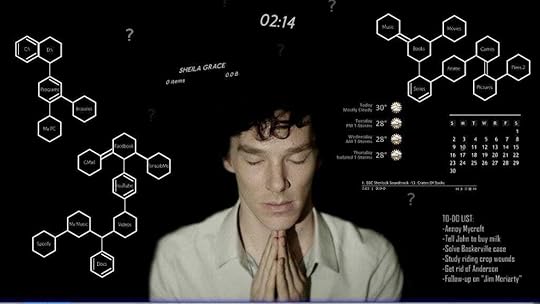 Sherlock did not invent the Mind Palace: he borrowed it from the anonymous Rhetorica ad Herennium, Cicero’s De Oratore, and Quintilian’s Institutio Oratoria.2.1. Mnemosyne’s Architecture: From Memory Palaces to Metadata
Sherlock did not invent the Mind Palace: he borrowed it from the anonymous Rhetorica ad Herennium, Cicero’s De Oratore, and Quintilian’s Institutio Oratoria.2.1. Mnemosyne’s Architecture: From Memory Palaces to MetadataIn Greek mythology, Mnemosyne, goddess of memory, was not merely a custodian of facts; she was the mother of the Muses. Memory, then, was not static—it was generative, the source of art, story, and song. Her architecture was fluid yet stable, an invisible scaffold on which the richness of human culture could be suspended. The memory palace technique was born within this cultural context, enriched by the Romans’ practical edge on politics, and formalised this principle. Thinkers like Cicero, Quintilian, and later medieval scholars described how a skilled practitioner could navigate through an imaginary building, each chamber holding a vivid, often surreal image linked to a concept or piece of information. The structure itself—the spatial organisation—was crucial. It provided retrieval hooks: a way for the mind to “walk” back through its own archive and find, not just data, but context, meaning, and associative richness.
In our own time, metadata plays a similar role. The “where” and “how” of information are almost as important as the information itself. Without tags, without relational structures, data floats unmoored, inaccessible. Metadata, like the mnemonic architecture of old, provides paths through chaos. It builds corridors where otherwise there would only be mist.
Yet there is a telling difference.
Where ancient memory palaces celebrated symbolic density, the metadata schemas of our age prefer minimalism. That’s the illuminists’ legacy, baby, and our ever-growing obsession for finding the perfect taxonomy, a way to classify stuff, One Metadatum to Rule Them All. A field labelled “Date Modified” or “Author” often lacks the imaginative punch of a flaming phoenix perched on a marble column, signalling the orator to recall the story of Icarus, but does it have to? We have gained precision but lost enchantment. The architecture of memory has become efficient to machines, but not necessarily memorable for people.
And herein lies a lesson: a machine-readable structure is not enough, and a retrieval system that forgets the texture of memory risks becoming nothing more than an index without a story. Codes need to be human-readable, and archive rules must stay within the human ability to comprehend and navigate them because they provide meaning within themselves.
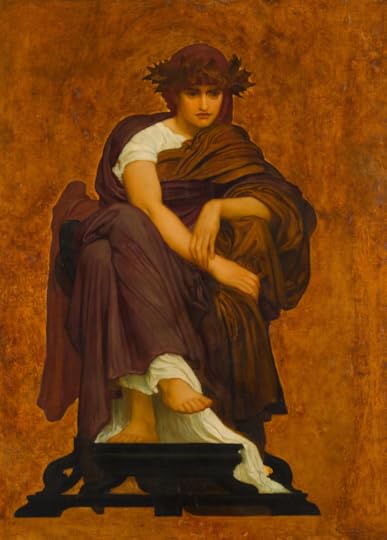 Mnemosyne, goddess of memory and mother of the muses, painted by Richard Leighton2.2. Ars Memoriae and the Roots of Information Storage
Mnemosyne, goddess of memory and mother of the muses, painted by Richard Leighton2.2. Ars Memoriae and the Roots of Information StorageThe Ars Memoriae—the art of memory—was not just a set of mnemonic tricks; it was considered, in the classical and medieval mind, a foundational technology of thought itself. To know how to remember was to know how to think. The ordering of knowledge was not arbitrary; it was a spiritual exercise, a discipline of the mind.
In the libraries of the Middle Ages, knowledge was organised according to practical and theological needs, driven by function and religious utility. There was a strong medieval tendency to see the cosmos, knowledge, and architecture as interconnected and reflective of divine order, sure, but stuff was organised based on correspondences, not Dewey decimals. Finding one precise piece of information was as important as encouraging human curiosity to peruse by association. While this approach has fundamentally changed, make no mistake: to store knowledge is always to interpret it, to decide what is worth remembering, how it should be linked, and who should have access.
As Mario Carpo has always stressed in his foundational texts (I talked about them extensively, peruse the archive), modernity brings a dangerous inversion: where the old masters of memory sought compression through vividness—an entire story remembered by a single icon—modern systems sought expansion through redundancy as soon as technology allowed. Backup upon backup, copy upon copy, mirror upon mirror. We trust in storage, but not necessarily in retrieval—or understanding.
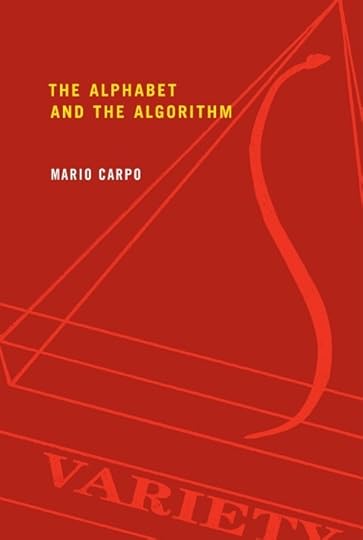 If you read one text on the topic, make sure it’s this.2.3. Redundancy, Noise, and Meaning in Systems
If you read one text on the topic, make sure it’s this.2.3. Redundancy, Noise, and Meaning in SystemsIf the ancients taught us about memory palaces, the moderns built transmission towers. With the 20th century came a new way of thinking about memory—not as a poetic structure for internal reflection, but as a problem of information transfer. In 1948, Claude Shannon, often called the father of information theory, published a seminal paper proposing that communication could be boiled down to binary signals, redundancy, and noise.
 Claude Shannon was this guy.
Claude Shannon was this guy.Shannon’s genius lay in separating meaning from transmission. For the engineer, it mattered not what the message said, but whether it could survive distortion. Redundancy, once seen as a flaw or inefficiency, became an essential tool: a way of ensuring that a message arrived intact, even across chaotic channels. In Shannon’s world, duplication wasn’t waste—it was armour against entropy.
Now consider Jorge Luis Borges, writing just a few years earlier. In The Library of Babel—written in 1941, around the same years Shannon was developing his theories—Borges conjured a universe composed entirely of books, every possible permutation of letters across a fixed length. Within that infinity, every possible truth exists—alongside every lie, every mistake, every meaningless jumble of symbols. Meaning is swallowed by abundance. Redundancy, instead of protecting information, obliterates it.
Where Shannon saw redundancy as a way to guard against noise, Borges saw it as a source of existential despair. Too many copies, too many variations, too much noise—and the fragile island of meaning sinks beneath a tide of gibberish. The contrast is striking. In Shannon’s mathematical landscape, redundancy is an engineering solution. In Borges’ literary cosmos, redundancy is an ontological nightmare.
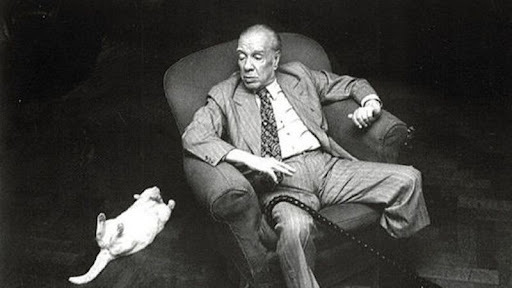 Jorge Luis Borges was this guy.
Jorge Luis Borges was this guy.And yet, both were grappling with the same essential problem we’re facing today in our own digital archives: how does information survive? How do we build systems—whether telegraphs or libraries or cloud archives—that protect the fragile signal against the inevitable decay of time, error, and misunderstanding?
Today’s digital archives embody both visions. Metadata tags, error-correcting codes, and blockchain ledgers all apply Shannon’s principles of resilient transmission. Meanwhile, the sheer volume of digital data—the endless backups, copies, revisions—threatens to recreate Borges’ infinite library, where the presence of everything ensures the retrieval of nothing.
In designing memory systems, we must balance these twin poles:
Redundancy as shield versus redundancy as suffocation.Storage as salvation of meaning versus storage as a pit of oblivion.Perhaps the perfect archive must be neither a sterile broadcast nor an endless labyrinth, but something else—a curated garden where meaning can survive without being drowned. The architect must ask not simply “Can I store this?”, but “Should I?”. And more daring still: “How will it live on, during the project?”
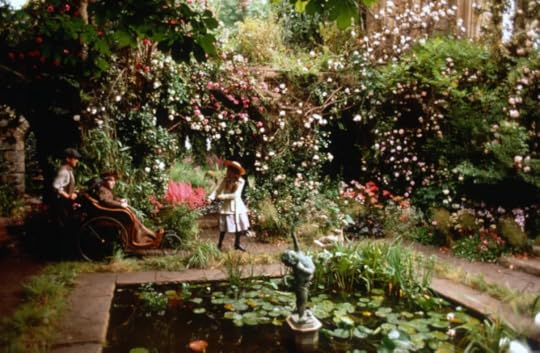 Don’t get me started on gardens: this piece will never end.3. The Construct of the Digital Archive
Don’t get me started on gardens: this piece will never end.3. The Construct of the Digital ArchiveIf the memory palace was a guided tour and the Library of Babel a blind wandering, the digital archive needs to support another activity: the autonomous search. Tagging and indexing are its navigational tools—the markers that help retrieve the right piece of information from an expanding sea of data.
Every time we label a file, add metadata to an image, or assign a keyword to a specification, we are not simply organising; we are shaping the pathways of discovery. Taxonomies, categories, and hierarchies are forms of storytelling in their own right, crafting routes that guide future users toward what they seek—or toward what we have anticipated they might seek.
Tagging is rarely neutral. Every keyword implies a perspective, a choice about how a piece of information fits into a broader structure of meaning. Is a document about “architecture” or “urbanism”? Should a photograph be categorised under “construction detail” or “construction flaw”? These decisions influence not only retrieval but also interpretation.
In fiction, Mr. Penumbra’s 24-Hour Bookstore stages this beautifully: Sloan’s protagonist uses both human intuition and algorithmic power to uncover hidden patterns—not in the books’ contents, but in the way they are organised. In doing so, the novel reminds us that how we search often determines what we find, and that the architecture of discovery is as significant as the artefacts themselves.
[image error] Please read this.In our own systems, every search engine result, every database query, reflects a hidden narrative about what has been stored, indexed, and linked. If we didn’t define the system’s architecture with this in mind, thd structure and narrative is totally unconscious, like that of a chicken piling LEGO bricks with its beak. The archive is not a passive container; it is a constructed environment, where meaning emerges not just from content, but from connections.
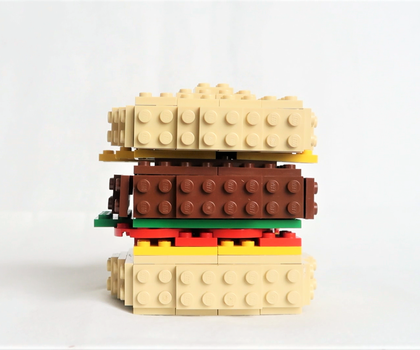 This sure looks like a structure, but is it intentional?3.1. Curating vs. Hoarding: How Stories Shape Data
This sure looks like a structure, but is it intentional?3.1. Curating vs. Hoarding: How Stories Shape DataNot all who gather are curators. Some simply hoard.
In the digital archive, the line between collection and clutter grows perilously thin. The temptation to store everything—every draft, every redundant photo, every forgotten email chain—is fueled less by a desire for meaning than by a fear of loss or, worst, the need to get out of hypothetical, future trouble. Every “just in case” file saved, every “final_final_v2” document tucked away in a forgotten folder, is a small act of anxiety: a hedge against forgetting, a talisman against the impermanence of our digital existence.
 I’m not a fan of Inside Out, but I am a fan of how their belief system is created through the meaning we give to memory, and the depiction of the panic attack as an avalanche of tucked-away memories is simply genius.
I’m not a fan of Inside Out, but I am a fan of how their belief system is created through the meaning we give to memory, and the depiction of the panic attack as an avalanche of tucked-away memories is simply genius.But accumulation without discernment leads to a slow suffocation of meaning. The more we gather indiscriminately, the more invisible each individual item becomes. Data piles up, thick and unstructured, until the archive becomes a graveyard—not of forgotten things, but of things that were never properly remembered in the first place.
Curation, by contrast, is an act of intentional storytelling. It is an editorial gesture, an active decision to shape memory, not merely to preserve it. To curate is to ask:
What matters here?What deserves to endure?What context does this memory need in order to be understood later?A curated archive says: This matters.
A hoarded archive begrudgingly mutters: Maybe something here will matter someday.
Carlos Ruiz Zafón’s The Shadow of the Wind captures this distinction vividly. In the Cemetery of Forgotten Books, entrance is not automatic. One must choose a single volume to “adopt,” to protect it from oblivion. Even in a library designed for loss, there is selection, stewardship, responsibility. Memory, in Zafón’s world, is not passive; it demands engagement. The books are not warehoused in bulk. They are given meaning by the fact that someone—reader, caretaker, future discoverer—cares enough to choose them.
In our digital systems, we too must learn to choose. And, ideally, not perish.
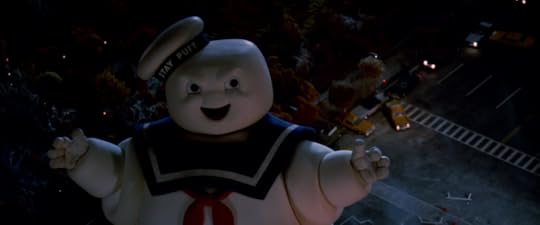 You know what to choose, if that’s the case.
You know what to choose, if that’s the case.We must resist the easy drift toward limitless accumulation and embrace the harder, slower work of storytelling through selection. Curation requires time, attention, and a willingness to say no. Not everything needs to be saved. Not every backup needs to be infinite.
Moreover, how we curate matters. Contextual metadata, careful categorization, meaningful tags, human-readable notes—these are the modern equivalent of illuminating a manuscript, adding a marginalia, carefully picking a Drop cap that drives home a message, or binding a codex with care. Without them, files may survive physically but die cognitively. Future readers (including ourselves) will find only shapeless noise where once there could have been living memory.
I know I said I wasn’t going to expand on this, but then again… the more I think about it, the more I feel gardening is a better metaphor than warehousing. The gardener does not try to grow everything at once. They prune, they weed, they plan for cycles of bloom and dormancy. In the same way, the storage portion of a Common Data Environment must be alive, evolving with its purpose and audience, allowing for both permanence and graceful forgetting.
 Mary, Mary, quite contrary…
Mary, Mary, quite contrary…Curation is not an act of nostalgia—it is a commitment to future meaning. It recognises that memory is finite, not infinite, and that its value lies precisely in its limitation: in what is remembered instead of everything else. In the design of digital archives, as in the stewardship of project memory, the ultimate question is not how much we can store, but what stories we choose to tell with what we keep.
Add another aspect on top of this. We act as if our archives can hold an infinite amount of data, but is that actually true and what’s the environmental impact of this belief? While data centres currently account for about 1% of global energy use and contribute approximately 2–4% of global carbon emissions, projections suggest that their usage of global electricity could rise from 3% to 10% by 2030, driven by increasing demand from AI and machine learning workloads.
So, what different approach might we adopt?
3.2. The Archive as Game: Oulipo, Constraints, and DesignConstraints breed creativity. The Oulipo group—Ouvroir de littérature potentielle, or “Workshop for Potential Literature”—embraced this principle with almost mathematical fervor. Writers like Raymond Queneau, Georges Perec (see here), and Italo Calvino experimented with formal limits: novels written without the letter “e” (La Disparition), stories generated by algorithmic permutations, poems unfolding along combinatorial grids. Constraints, for the Oulipo, were not cages but engines. By setting boundaries—rules, limits, formulas—they unlocked new territories of expression that would otherwise remain hidden. Freedom was not the absence of limits; it was the richness found within them.
In the world of digital archives, this lesson is just as vital.
Without constraints, archives grow wild and unstructured, threatening to drown users in undifferentiated bulk. Every file saved without a schema, every dataset indexed without a taxonomy, every uncontrolled vocabulary breeds confusion. Discovery becomes harder, not easier, as options proliferate without guidance. And while we are listening to the courting songs of AI, promising to create flexible scaffolds of meaning around our digital mess, what are we prepared to lose when we relinquish curation? Have we really given it enough thought? Can we train a machine to do something we don’t actually understand?
 I’m sure Libby can help me find the book I’m looking for, but can he advise me on searching for something I didn’t know I needed?
I’m sure Libby can help me find the book I’m looking for, but can he advise me on searching for something I didn’t know I needed?Constraints in archive design—through metadata standards, controlled vocabularies, access protocols, modular storage rules—turn accumulation into intelligible structure. They guide users along designed paths without scripting every move, and offer navigational scaffolding without dictating the journey’s meaning. That’s the work of an architect and a manager of a Common Data Environment. Not assigning reading vs writing permits in folders.
In this sense, Calvino’s Invisible Cities offers a profound model.
The novel’s intricate architecture—a precisely ordered series of dialogues, cities grouped and repeated across thematic axes—does not confine the reader’s imagination. Instead, it amplifies it. The strict formal structure creates resonances, echoes, and hidden symmetries that invite readers to participate, to notice patterns, to build their own internal maps of Marco Polo’s shifting cities, and to read the novel in a non-linear fashion, pursuing those patterns.
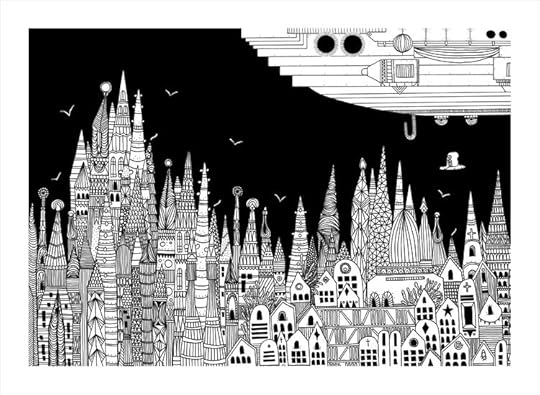 One of Karina Puente’s illustrations to Calvino’s Cities: Ipazia.
One of Karina Puente’s illustrations to Calvino’s Cities: Ipazia.An effective digital archive might work the same way.
Rather than presenting data as a flat inventory, it can be structured like a game board, a matrix of possibilities where users follow relational references, encounter unexpected juxtapositions, and assemble meaning through interaction. Constraints, far from being limitations, shape user experience and define the grammar of interaction. Faceted search, curated pathways, dynamically generated clusters of related materials—all these design choices echo Oulipian principles, turning the archive from a static warehouse into an active exploration, and it’s entirely within the possibility of our current technology. We’re just too busy renaming files to pursue it.
Moreover, constraints act as memory’s protectors. By deciding what types of data are admissible, how they must be described, and in what relationships they must stand, the manager preserves the possibility of future understanding. An archive without structure risks becoming, once again, Borges’ Library of Babel—vast, infinite, but ultimately unreadable.
Thus, the future of the Common Data Environment might demand a shift: from a container of information to a designed experience, a balance between rigidity and openness, order and imagination. The most enduring memory systems will not be those that store the most, but those that invite the richest and meaningful exploration.
4. Designing the Archive of the FutureNow, what do I mean when I say that the technology exists? Let’s take a closer look.
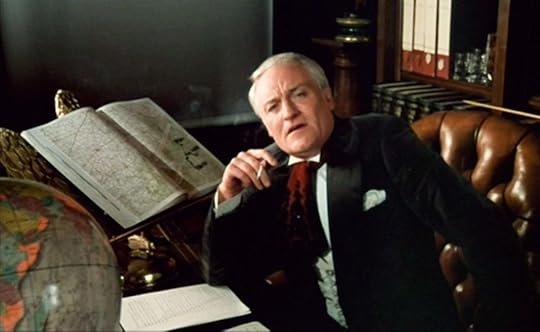 “I would like, if I may, to take you on a strange journey”4.1. The Archive Status. A.k.a. Can a Library Be Infinite and Useful?
“I would like, if I may, to take you on a strange journey”4.1. The Archive Status. A.k.a. Can a Library Be Infinite and Useful?The dream of the infinite library persists, and I won’t be the one to banish it from your imagination. It flickers in Borges’ Library of Babel, resurfaces in the boundless databases of Google, and echoes in every ambitious digital repository that promises to preserve everything. In theory, an infinite archive offers limitless discovery: every fact, every version, every forgotten trace made eternally retrievable. As we have seen, discovery doesn’t seem possible without structure. And infinity with structure is a paradox.
As Borges understood all too well, a library containing every book ever written—including every possible combination of letters—is not a paradise but a nightmare.
A useful archive, no matter how vast, must therefore impose limits of intelligibility. It must structure infinity into zones of relevance. It must prune, prioritize, and organize—not to diminish knowledge, but to make it reachable.
But I can’t decide to delete stuff.
I know, darling, I know.
 Please don’t be scared: I might have solutions.
Please don’t be scared: I might have solutions.One possible compromise, that doesn’t address the environmental issue but at least tries to recuperate meaning for our Common Data Environment, is this: an infinite archive is possible only if it is also finite at the point of encounter, offering the right document at the right time to the right seeker. Otherwise, the user is left adrift, shipwrecked on the endless shores of possibility.
That’s why we have the Common Data Environment’s archive status, right? To keep out of the way whatever’s no longer relevant.
 This little guy over here.
This little guy over here.And yet, the absence of arrows in that well-known scheme of the international norm speaks volumes: how do we get there? DO WE get there? And why? With whose clearances? Under which circumstances? An archive that’s really dynamic will not merely scale that section horizontally by adding more data or by keeping piling superseded versions upon superseded versions. It will scale vertically by adding layers of meaning, filters of interpretation, and maps of guidance to retrieve how we got to the current point in the project and—maybe—what went wrong. Usefulness is not the enemy of infinity; it is its steward.
4.2. The Classification Systems. A.k.a. From Dewey to Deep LearningClassification systems have always reflected philosophies of order. I speak at length about it at the beginning of pretty much every lesson on Levels of Development and Work Breakdown Structures, involving people like Raymond Lull, Pierre de la Ramée, Conrad Gessner and Paul Otlet (see here).
Melvil Dewey’s Decimal System, born in the 19th century, is one of those milestones that divided human knowledge into rigid, numbered categories—a structure that, despite its endurance, reveals a very particular worldview: hierarchical, Western-centric, and increasingly outdated.
Librarians everywhere, please don’t hate me. For everybody else, the Dewey Decimal System remains the most widely used library classification scheme globally, used in over 200,000 libraries in at least 135 countries, and I know it’s being continuously updated to better accommodate new fields and perspectives. I know you’re trying.
 It’s never wise to upset a librarian
It’s never wise to upset a librarianToday’s information architects face a new challenge. The rise of deep learning and AI-driven retrieval threatens to make traditional categories obsolete and, as we have seen, that might not be a bad thing. In theory. Neural networks group information not by predefined taxonomies, but by fluid patterns of association. A photograph, a text snippet, and a drawing may cluster together not because they belong to the same “subject,” but because some latent vector hints at a shared essence.
Those systems, however, require designing, else the risk of delegating to the spontaneous definition of meaning inherent in neural networks. Also, designing systems isn’t enough: systems will have to be used by people. These new tools demand a new sensibility—a poetics of interface—that moves beyond rigid folders and static indexes. Interfaces must invite exploration, not just retrieval. They must allow users to connect across categories, to glimpse unexpected affinities. They must offer not just answers, but encounters with knowledge. Imagine, if you will, an archive where searching for “memory” brings you not only scientific papers, but also paintings, personal letters, city maps, and forgotten myths. Where meaning is discovered relationally, dynamically, through an interplay of forms. This isn’t any different than the concept of the Medieval library, if you’ve been paying attention.
Maybe not this one.Conclusion: Literary Templates for the Ethical Archive. Ak.a. What Fiction Teaches TechFantastic and sci-fi literature, far from being a relic, offers powerful templates for how we might design and govern our technological solutions.
In The Name of the Rose, Eco warns us that access is power, and that curating knowledge carries ethical stakes.
In Mr. Penumbra’s 24-Hour Bookstore, Sloan shows how digital tools can extend, but not replace, the thrill of human curiosity.
In The Shadow of the Wind, Zafón reminds us that archives are repositories not just of data, but of personal histories and emotional debts.
From these literary visions, we can extract guiding principles:
Curation matters as much as storage. Not everything needs to be saved; some things must be chosen.Context must be preserved. A document divorced from its origins is a memory without meaning.Discovery should remain an adventure. Archives must nurture curiosity, not just efficiency.Access must be equitable and ethical. Not all memories are harmless; not all knowledge should be stripped of its consequences.Fiction shows us that an archive is never neutral. It is a place where values are encoded into every organisational choice, every retrieval algorithm, every forgotten folder. How’s your Common Data Environment structured these days?
Bookish ReferencesThe Library of Babel by Jorge Luis BorgesInvisible Cities by Italo CalvinoThe Name of the Rose by Umberto EcoMr. Penumbra’s 24-Hour Bookstore by Robin SloanThe Shadow of the Wind by Carlos Ruiz ZafónThe Archivist by Martha CooleyThe Library at Mount Char by Scott HawkinsMay 4, 2025
Felice Casorati in Milan
In the rich tapestry of 20th-century Italian art, Felice Casorati is a figure of striking elegance and introspection at the crossroads of symbolism, metaphysical painting, and the classic Italian tradition. Casorati did not simply paint; he composed visual odes to silence, to structure, and to the inner life of forms. His work stands as a compelling testament to the contemplative potential of art in a world increasingly drawn to speed and spectacle. Now you go ahead and tell it’s not relevant.
What draws me most to Casorati’s work is the paradox he mastered: the ability to infuse rigid geometry with raw emotion. His paintings—seemingly cold and constructed—are in fact vibrantly alive with inner tension whether he portrayed women in long, static poses or still lifes arranged with almost scientific care, there is always something stirring beneath the surface. His figures, so serene, often radiate a subtle anguish or longing, suspended in rooms that seem both timeless and placeless. It’s as if he painted the architecture of the soul.
Casorati’s love of structure owes something to his early training in music and his brief foray into law before he fully committed to painting. The discipline of those pursuits shines through in his canvases, where each element seems deliberately placed, not a stroke out of order, yet the result is never sterile, and the quietude of his compositions invites the viewer into a space of reflection. There is a rhythm to his work that resonates like a sonata played in a hushed room.
In paintings such as Silvana Cenni (1922), one sees Casorati’s mastery of psychological depth. The young woman’s distant gaze, her elongated form, her enthroned pose like a Priestess of Tarots, the delicately flattened perspective—all contribute to a sensation of stillness so profound it feels sacred. In that space, the viewer is a participant in an unspoken conversation between presence and absence.
Maybe this is why Casorati is often linked to the metaphysical painting of de Chirico and Carrà, and while the connections are there—particularly in his use of empty, dreamlike spaces—he is no imitator. Where de Chirico’s cities are haunted by mystery and dread, Casorati’s interiors are imbued with restraint and calm. His classicism is not nostalgic but modern, a response to chaos with clarity. And yet, what I find most profound is that his classicism is never cold. In Casorati’s work, the past is not a relic but a living guide. He speaks to us not through grand gestures or historical narrative, but through the poetics of line, form, and gaze. His figures may be frozen in time, but they pulse with quiet intensity.
The ShowFrom February 15 to June 29, Palazzo Reale in Milan hosts a major retrospective dedicated to the influential Italian artist. This exhibition marks Casorati’s return to Milan after 35 years, following his last major show at Palazzo Reale in 1990. Curated by Giorgina Bertolino, Fernando Mazzocca, and Francesco Poli, the exhibition features over 100 works, including paintings, sculptures, drawings, and stage designs, offering a comprehensive overview of Casorati’s artistic journey.
The exhibition is organised chronologically across 14 rooms, tracing Casorati’s evolution from his early realist and symbolist works to his mature style characterised by metaphysical and magical realism elements. Notable pieces on display include “Ritratto della sorella Elvira” (1907), “Silvana Cenni” (1922), and “Le sorelle Pontorno” (1937).
The exhibition also emphasises Casorati’s connection to Milan, a city he considered strategically important for its vibrant art scene; Casorati’s multifaceted talent extended beyond painting; he was also a sculptor, graphic artist, and stage designer. His contributions to theatre are highlighted through sketches and designs for productions at venues like Teatro alla Scala.
1. From Padua to Naples: The Early AdventuresFelice Casorati may have started his artistic journey in 1904 at the Philharmonic Circle in Padua, but his real breakthrough came in 1907 at the Venice Biennale. There, as we have seen, he made waves with his evocative Portrait of Sister Elvira—a dreamy composition featuring a misty oval halo framing her face and a delicately gloved hand. It’s also the perfect ratio for an Instagram story, for some reason.
By 1909, Casorati had packed his bags and moved to Naples with his family. For that year’s Biennale, he upped the ante with The Old Women—a bold piece snapped up by the Italian government for Rome’s National Gallery of Modern Art. Critics were wowed by the “masterful composition,” rich colours, and emotionally intense portrayals of timeworn faces.
Casorati wasn’t just painting from imagination—he was strolling through museums to seek intellectual validation for his inspiration. His studies of the old masters at Capodimonte and the Uffizi clearly left their mark. In particular, Bruegel’s Parable of the Blind made an impression. You can catch nods to Botticelli, Velázquez, and Titian in later works like Children in the Meadow and The Heiresses.
But perhaps his most original piece from the Naples chapter is People, a cryptic and slightly surreal painting that feels like a poetic riddle. One critic described it beautifully as “the end of a meal of memories”—a perfect way to sum up Casorati’s early period: rich, layered, and lingering long after you’ve taken it in.
2. Allegories, Symbols, and a Dash of Drama: Casorati in Verona (1912–1914)My personal favourite section of the exhibition covers the span of two years in which he was most influenced by Symbolism and other artists like Gustav Klimt.
By 1912, Felice Casorati was no longer just “one to watch”—he was officially regarded as one of the most prominent artists of his time. His painting Signorine, fresh from its debut at the Venice Biennale, was scooped up by the International Gallery of Modern Art at Ca’ Pesaro in Venice. With this work, Casorati sealed his place as one of the key voices of European Symbolism.
Set against a leafy backdrop, Signorine channels major Primavera energy à la Botticelli. Four women appear, each with a dramatic persona straight out of a Renaissance mood board: Dolores, the personification of grief; Violante, steeped in melancholy; Bianca, radiating purity; and Gioconda, the happy housewife archetype, basking in matrimonial bliss. At their feet, a still life of jewels, mementoes and bourgeois tokens.
Casorati’s brush was clearly being guided by more than just the muses—enter Gustav Klimt. After being thoroughly wowed by Klimt’s work at the 1910 Biennale (where Casorati’s own work was prominently featured), our local painter took a stylistic leap. The result was a deep dive into dreamlike Symbolism with a Viennese twist I’m only sad it didn’t last longer.
Between 1913 and 1914, Casorati produced some of his most emotionally resonant pieces, such as Nocturne, Two Figures, and The Milky Way. These works reflect not only a surreal, almost magical atmosphere but also his bold experiments with form and design.
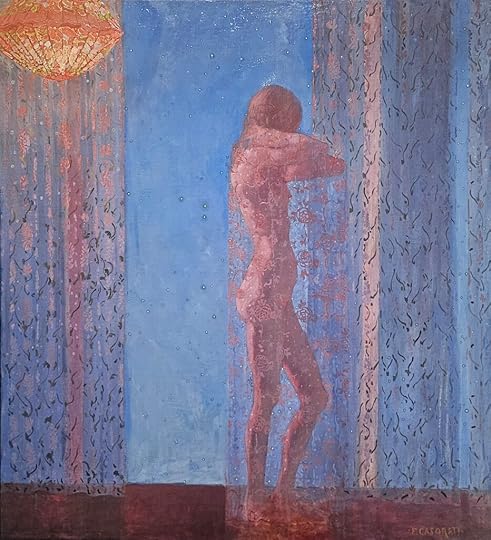 This is, without any doubt, my favourite.3. Grand Temperas and Quiet Drama: Casorati in Turin (1918–1920)
This is, without any doubt, my favourite.3. Grand Temperas and Quiet Drama: Casorati in Turin (1918–1920)In 1918, still in Verona, Felice Casorati dove headfirst into what would become one of the most striking chapters of his career: the era of the grand temperas. This series kicked off with the ghostly portrait of Teresa Madinelli Veronesi, quickly followed by the quietly haunting The Waiting and the metaphysical vision of Maria Anna De Lisi in Girl with a Bowl. By 1919–1920, Casorati wrapped up the cycle with The Man with the Barrels and Morning.
These works—and those from the early 1920s—cemented Casorati’s signature style: instantly recognisable and now a favourite of critics and art collectors alike. What makes them so unforgettable are the desolate interiors, carefully staged as if to create a mental landscape rather than a physical space. The figures within are stripped of realistic detail, frozen in stylised poses and garments that feel more symbolic than specific.
The atmosphere is heavy with anticipation and anxiety. Everyone—and everything—seems to be waiting, stuck in a quiet emotional limbo. Even the mundane objects, like the bowl and cutlery in The Waiting, seem to be emotionally checked out, almost slipping out of the frame. In Maria Anna De Lisi, the iconic terracotta sculpture Head of Ada silently converses with the solemn, statuesque presence of the model, creating an eerie sense of suspended dialogue. And the exhibition pairs them masterfully.
Casorati’s temperas aren’t just paintings—they’re psychological spaces. Still, silent, and unsettling in the most beautiful way.
4. Masks, Armour, and a Touch of Rebellion: Casorati Between 1914–1921A new era, which seems to be the natural development of both symbolism and the temperas’ anxiety, kicks off with the unexpected Joke: Marionettes in 1914. He began crafting what critics called “artificial still lifes”—not your average fruit bowls and flower vases, but staged objects with a conceptual edge. These works marked his deliberate break from Symbolism and decorative flourishes, aiming instead for a stripped-down, pure kind of painting.
What’s fascinating about this phase is its unsettling, playful spirit, like a horror house. You can see it clearly in Toys, one of the few paintings Casorati completed during World War I, and especially in the wildly provocative Target Practice. When he exhibited this work in Turin in 1919, it caused quite a stir. Some critics even accused him of dabbling in Futurism, scandalised by the almost abstract, distorted forms of carnival-style shooting range targets. It makes me laugh so much.
Then there’s Masks, a still life set in his studio that subtly introduces an unexpected guest: a helmet. This curious detail becomes a key motif in The Woman and the Armour, where it looms in the background, setting up a silent tension with the quietly introspective nude figure resting in the foreground.
This was Casorati in transformation—playful, provocative, and experimenting with visual language that left Symbolism behind, but carried its theatrical soul forward in entirely new ways.
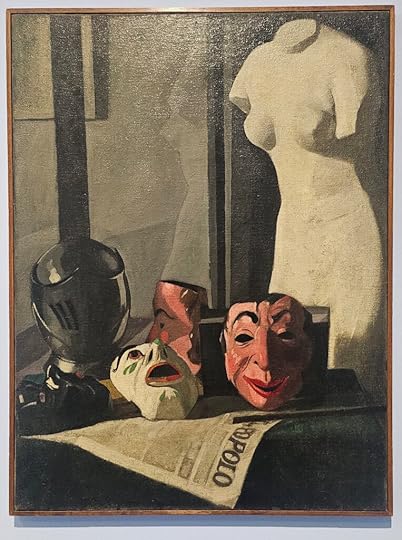 Masks is, without any doubt, my second favourite painting of the show.5. Silvana Cenni (1922): Eggs, Icons, and Imagined Saints
Masks is, without any doubt, my second favourite painting of the show.5. Silvana Cenni (1922): Eggs, Icons, and Imagined SaintsAnd now it’s time to talk about eggs. Yes, eggs. When Felice Casorati painted Eggs on the Drawer, critics like Piero Gobetti and Lionello Venturi were genuinely thrilled. Why? Because the piece was a breath of fresh air: perfectly composed, subtly colored (“humble hues,” as Venturi put it), and marked by forms that were both loved and familiar. It signalled what they called “a new light, anti-Impressionist” and a confident leap into a style all Casorati’s own.
There were whispers of Cézanne, of course—Casorati had admired his work at the 1920 Venice Biennale—but those enigmatic eggs carried a different weight. With their sculptural perfection, they seemed to echo Piero della Francesca’s sacred geometry, especially the Brera Altarpiece, where a single egg hangs as a mystical focal point.
Enter Silvana Cenni, perhaps Casorati’s most famous painting. This large-scale tempera work is both monumental and intimate—a reinterpretation of Renaissance Madonna imagery seen through a modern, deeply personal lens. Painted in 1922 and measuring 205 x 105 cm, it’s widely regarded as one of the artist’s most significant and enigmatic works. The portrait depicts a woman seated on a wooden chair draped with a damask cloth. She is dressed in white, with her hair neatly gathered, her eyes closed, and her arms resting on the chair’s back, hands relaxed and lowered. Around her are books, scrolls, and various objects, suggesting an intellectual or artistic environment. Behind her, through a window, one sees fields and the distinctive silhouette of a monastery with a portico and distant hills.
According to the curators, it draws directly from Della Francesca’s Polyptych of Mercy. I don’t see it, but I’ll let you be the judge of that.
Despite its religious air, Silvana Cenni is a fictional portrait. The name is made up. There’s no Silvana Cenni. There never were. But that only adds to the mystique. Casorati gives his imagined woman the gravitas of a literary heroine. She’s been called a “ghost woman”—seated like a statue, stiff yet serene, backed by a classical-style building reminiscent of Turin’s Church of Santa Maria del Monte on Cappuccini Hill. A Madonna, a phantom, or a timeless muse. Silvana Cenni stands as a symbol of Casorati’s unique vision: classical, modern, and unmistakably his.
6. A Private Stage and Public Style: Casorati & the Gualinos (1922–1926)Between 1922 and 1926, Felice Casorati found himself at the heart of an artistic alliance with Riccardo and Cesarina Gualino—the power couple of cultural life in 1920s Turin. Patrons, collectors, and tastemakers, the Gualinos commissioned Casorati to capture their portraits in a Renaissance-inspired style, though dressed in chic modern garb. Classical poses with contemporary flair, we might say.
Casorati showed off these portraits at the 1923 Turin Quadrennial and again at the 1924 Venice Biennale, where he also unveiled a portrait of their son. These artworks reflected the luxurious aesthetic of the Gualinos’ Turin residence—an interior soaked in opulence, funded by Riccardo’s booming business empire.
But the real jewel of this collaboration was a private theatre, dreamed up by the Gualinos and entrusted to Casorati in 1924. Designed with architect Alberto Sartoris, the space was a minimalist marvel: black seating, grey walls, and pristine white bas-reliefs (three of which are on view in the exhibition).
The theatre wasn’t just for show. It hosted concerts, poetry readings, and modern dance performances, often led by Cesarina Gualino and the Markman sisters—who are themselves immortalised in one of Casorati’s tempera portraits, Raja. One notable figure who stepped onto that stage was composer Alfredo Casella, painted by Casorati in 1926, who conducted a concert dedicated to Igor Stravinsky.
7. Back at the Venice Biennale (1924): Light, Form, and a Lost MasterpieceCasorati came back to Venice in 1924, with a personal exhibition at the Venice Biennale. Out of the fourteen works he showcased the first time, seven make a comeback in this current exhibition. Among them are portraits of the Gualino family, Meriggio, Double Portrait, Portrait of Hena Rigotti, and Mannequins.
A black-and-white photo from that Biennale also offers a tantalising glimpse of Studio, a now-lost masterpiece tragically destroyed in the 1931 fire at Munich’s Glass Palace. But even without it, the works from Venice reveal Casorati at a turning point—embracing tradition while boldly crafting his own language of form.
Among the most talked-about works in Venice was Portrait of Hena Rigotti, posed almost like a modern-day Virgin Mary. Casorati cleverly placed her against the familiar backdrop of his earlier Portrait of Maria Anna De Lisi from 1919, blending past and present. And then there’s Mannequins, where Casorati paints himself reflected in a mirror—one of his rare and nearly silent self-portraits.
The success of this 1924 solo show didn’t just boost his reputation in Italy. It catapulted Casorati into the international art scene, opening doors to exhibitions across Europe and the United States.
Influenced by the broader post-war return to order and craft, Casorati’s paintings from this period celebrate structure and classical sensibilities. Colour becomes a vehicle for light, and his brushwork takes on a polished smoothness. Flesh appears porcelain-like, dishes gleam with enamel sheen, and details like the soft hat and slippers in Meriggio add a tactile richness that became a hallmark of Casorati’s style.
8. Platonic Conversations (1925–1930): an accidental inspirationSometimes, great art begins by chance. That’s exactly how Felice Casorati described the birth of Platonic Conversation. One day, a friend stopped by his studio during a nude posing session. Casorati later recalled, “I don’t quite know what I felt, but I saw the painting—the painting I wanted to make.” It was a moment of serendipity: the sombre, modest figure of the man juxtaposed against the luminous, almost blindingly glazed surface of the woman’s body.
When Casorati exhibited the painting in 1926 at the First National Exhibition of 20th-Century Italian Art in Milan—curated by Margherita Sarfatti—it caught the critics’ attention. The two figures in the painting, posed together with a strange air of restrained sensuality, sparked a lively public debate in newspapers: was this an exploration of gender dynamics? A commentary on the relationship between men and women?
Between the first Platonic Conversation (1925) and the second (1929), Casorati’s work entered a new phase. He gradually moved away from classical formality—not through rebellion, but through a shift in his style and materials. His palette changed, as did his handling of paint, which became more opaque, even porous in texture. I strongly prefer the first (so much that I didn’t even take a picture of the second one).
This evolution is especially visible in Annunciation (a work recently brought back into public view) and Beethoven—two paintings that share the recurring motif of the mirror. During this period, Casorati also deepened his love for still lifes, a genre he described as offering “the most beautiful and most free architecture” for a painter to explore.
 A detail from Beethoven. I know it’s not the name of the dog, but I like to think it is.9. The Springtime of Painting (1927–1932): Light, Stillness, and Symbolic Fruit
A detail from Beethoven. I know it’s not the name of the dog, but I like to think it is.9. The Springtime of Painting (1927–1932): Light, Stillness, and Symbolic FruitSpring had a special meaning for Felice Casorati—not just as a season, but as a metaphor for artistic renewal. He even added “Primavera” to titles like April and Portrait of a Young Girl, as if to underline the warm, fresh air that his evolving style was starting to breathe.
By the time of the 1930 Venice Biennale, critics were recognising a “new Casorati.” His figures were now wrapped in soft atmospheric tones—not realistic, but radiant in a dreamy way. Set in calm domestic interiors, his characters were surrounded by familiar household items: a basin and mirror in April; a watering can, a mat, and a dish towel in Portrait of a Young Girl. These weren’t just background props—they were part of a quiet, staged intimacy.
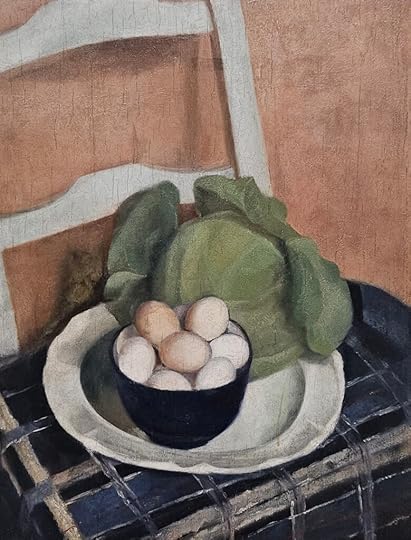 And Eggs. More Eggs.
And Eggs. More Eggs.Around this time, Casorati began expanding his visual vocabulary of femininity. He introduced a broader variety of female forms, moving between delicate, slender bodies and more statuesque, solid types, all rendered with elegant, almost sculptural distortion.
In Girls in Nervi, for instance, the woman on the right is a striking figure in a turquoise dress—regal, still, and monumental. This painting is many things at once: a figure composition, a seascape, and even a still life, with a tray of fruit prominently displayed in the foreground. The silent tension between the two girls plays out entirely in the expressive choreography of their hands.
One of Casorati’s most striking colourist achievements from this period comes in Apples (1932). These are no ordinary apples—they are luscious, red and green, nestled into folds of dusty pink fabric, transformed into near-mythical fruit, glowing like something from a fairy tale.
10. The Melancholic Figures (1931–1937): Stillness, Silence, and Emotional GravityThere’s a quiet melancholy that lingers in many of Felice Casorati’s works from the 1930s. A mood of meditative stillness—tinged with vulnerability, introspection, and waiting—settles over his portraits of women and girls, whether clothed or nude. These are not dramatic scenes, but carefully crafted tensions between psychological depth and compositional restraint.
Take Woman with a Cloak, for instance: seated on a plain chair in a bare room, she folds in on herself, a figure of sorrow and solitude. Casorati painted her with a rare emotional intensity, capturing her as someone enclosed in her own world.
In Girl in Pavarolo (also known as Clelia), we meet a fragile young adolescent, bare-chested and seated with her hands in her lap. The soft greens and blues that bathe the scene lend it a tender, more bittersweet sense of melancholy—less stark, more dreamlike.
One of the most striking works of this phase is Woman at the Table, created in the mid-1930s. The composition unfolds on two levels: the figure in the foreground, and behind her, a still life of domestic objects laid out on a table. The woman herself, semi-nude, leans forward with her chest bare. One hand rests on her thigh, the other cradles her head, and her entire posture radiates a quiet yet theatrical sorrow. It’s a study in melancholic grace—where stillness becomes its own kind of drama.
11. Masterpieces of the 1930s (1933–1937): Serenity, Symbols, and SistersAmong the standout works featured in Felice Casorati’s personal exhibition at the 1934 Venice Biennale were three major pieces described as true pièces de résistance: Daphne in Pavarolo and Women in a Boat. Out of the thirteen paintings he exhibited, these stood out for their beauty, symbolism, and quiet emotional power.
Daphne in Pavarolo is a portrait of calm and harmony. Casorati paints his wife Daphne seated on a windowsill, looking out over the soft, undulating hills of the countryside around their home. The scene is a symbol of his emotional peace and marks a shift in his painting—away from the formal confines of the studio and into the natural world beyond.
Women in a Boat is a more constructed and sculptural composition, shaped like a dreamy allegory of life itself. Set in a mythic, timeless space, the painting revolves around a woman nursing her child, bathed in a poetic, almost suspended atmosphere that feels part dream, part memory.
That same tender image—a mother nursing her child—reappears in The Pontorno Sisters, one of the defining masterpieces of Casorati’s late 1930s output. Presented at the 1938 Venice Biennale, the painting captures a scene of delicate domestic intimacy: sisters sharing a quiet moment in a simple room, filled with soft light and a peaceful, tonal calm.
These works show Casorati at his most emotionally resonant, merging myth, memory, and the everyday into something timeless.
12. The Enigma of Narcissus (1937–1944): Fragile Beauty and Silent TensionFrom the late 1930s onward, Felice Casorati turned his gaze to more vulnerable subjects—specifically, young boys portrayed in their delicate, exposed nudity. One of the most poignant examples is the mysterious Narcissus, a loose evocation of the ancient myth. In this painting, a fragile, nude boy stands in the foreground, his eyes cast downward toward a mirror placed on the floor. This modern-day Narcissus, alone in a bare, desolate room, stands motionless in a posture that radiates sorrow and isolation. Behind him, two modestly dressed young girls linger in the background, their hesitant gestures suggesting an awareness of something tragic yet unspoken.
There’s an underlying tension in these scenes—a quiet, haunting unease shaped by the looming shadow of wartime. You feel it not only in Narcissus, but also in the subdued chromatic atmosphere of works like The Green Nude, where a young girl sits in a chair, and Two Women, where a wordless conversation unfolds between two female figures.
One of the most visually arresting pieces in this group is Back Nude, a large-format painting executed with refined elegance. The composition features a woman seen from behind, her long red hair cascading over her back. Her gracefully curved silhouette stands out in front of a softly lit windowed door, creating a powerful contrast of presence and absence, form and fading.
In these late works, Casorati blends myth, memory, and emotional fragility into a still, suspended world—one where the body becomes both subject and symbol.
13. The Strategy of Composition: Still Lifes (1947–1953)For Casorati, still life painting was never just about objects—it was a key laboratory for refining his compositional strategy throughout his career. In this genre, he achieved some of his most extraordinary results, using it to explore essential aspects of his aesthetic vision. Of particular interest for the show are the still lifes from the late 1940s and post-war period. Here, Casorati revisits his favourite themes, but with increasingly refined formal and chromatic solutions that gradually become more stylised and synthetic in appearance. There’s also a series of still lifes with strong symbolic resonance, which feature plaster casts (of feet, hands, arms, classical busts), mannequins, masks, and heads—recycled and reimagined from his earlier works. I love them to bits.
One especially inventive work is Paralleli—on the right in the picture above—where Casorati suggests the presence of a female figure using only fragments of plaster body parts placed on layered, stratified surfaces. In Eclipse of the Moon—above in the middle—he proposes what feels like a miniature theatrical set, with an astrolabe positioned at the center, flanked by two vertical panels that function almost like curtains on a stage. Then there’s Still Life with Helmet—on the left—a composition made of ovoid forms, where Casorati plays an elegant formal game with abstract undertones. The two eggs placed in the arrangement aren’t just decorative—they’re carefully chosen elements that carry symbolic and visual weight. Casorati sure loved his eggs.
14. Casorati at La Scala (1947–1951): From Canvas to StageAs we have seen with the theatre, Felice Casorati wasn’t only a master of the canvas—he had a spatial sensibility akin to an architect, and he brought that creative vision to the theatrical stage. His long-standing collaboration with Milan’s Teatro alla Scala began in 1942 with set designs and costume sketches for La donna serpente, a fantastical opera by Alfredo Casella.
Over the next decade, Casorati would design for seven more productions, a journey captured in this exhibition through a selection of his stunning scenic and costume work.
From La follia di Orlando, a ballet by Goffredo Petrassi, we see Casorati’s whimsical set sketches and costume designs for the characters Astolfo and Medoro—both full of imagination and flair. For The Bacchae by Giorgio Federico Ghedini, he reimagined the mythic drama in rich operatic tones, with classical stage structures reminiscent of regal architecture.
And finally, for Bartók’s The Wooden Prince, Casorati fully embraced fantasy. His dreamlike sets are straight out of a fairy tale, complete with enchanted forests and pointed castle towers rising from the stage like something out of a storybook. Through his work at La Scala, Casorati brought the same sensitivity, structure, and elegance that defined his paintings into the realm of performance, crafting entire worlds for opera and ballet.
May 1, 2025
What to Catch in Milan This Month
Are you in Milan in May and looking for something to do? Were you left behind during the Design Week, and you are now wondering where everybody went? Don’t worry, I’ve got your back. Here’s a selection of things you can do in Milan, both digital and cultural. They’re based on my taste. Meaning that, if I missed something, you can try and tell me but I don’t guarantee I’ll want to include it, alright? Good.
DigitalAI Week 2025
Fiera Milano Rho
May 13–14 (in-person), May 12, 15–16 (online)
AI WEEK 2025 is set to be Europe’s premier artificial intelligence gathering, featuring over 250 international speakers across 10 stages. Highlights include a keynote by Zack Kass, former Head of Go-To-Market at OpenAI, and sessions on generative AI, Midjourney, and AI applications in business and sustainability. The event offers both in-person and online experiences, providing a comprehensive look into the future of AI.
I’ll get into more detail around May, 10th. Meanwhile, you can take a look at the event’s website.
CulturalInequalities, Triennale MilanoMay 13 – November 9, 2025
The Triennale’s 24th International Exhibition: “Inequalities” engages with global perspectives on inequality through contributions from designers, architects, and artists worldwide. The exhibition invites reflection on contemporary social challenges.
I’ll catch it next month.
I am Leonor Fini, Palazzo RealeUntil June 22, 2025
Explore the surreal and powerful imagery of Leonor Fini, an artist known for challenging traditional gender constructs. This exhibition showcases her visionary works, highlighting her contributions to the surrealist movement. I talked about her here.
The Seduction of Colour: Andrea Solario and Renaissance between Italy and France, Museo Poldi PezzoliMarch 26 – June 30, 2025
This landmark exhibition celebrates the 500th anniversary of Andrea Solario’s death with an unprecedented collection of around 30 works from major institutions in Italy, France, and the UK. Curated in collaboration with the Musée du Louvre, it explores the Lombard painter’s refined technique, influenced by Bellini, Antonello da Messina, and Leonardo da Vinci.
Visitors will journey through Solario’s artistic evolution—from youthful experiments to mature masterpieces—enhanced by diagnostic imaging and recent restorations. This fusion of art, science, and history offers a rare glimpse into the Renaissance through vibrant colours and intricate techniques.
This exhibition is a must-see for Renaissance enthusiasts and anyone passionate about the dialogue between art and scientific discovery.
Esodo Pratelli, from Futurism to the “Novecento” and beyond. Centro Culturale di Milano, Largo Corsia dei Servi 4Until May 13, 2025
The cultural centre is an unfortunately shallow space, seemingly abandoned, right in the centre of a square, a stone’s throw from Duomo, but it’s not their fault. It’s the original architect, no other than Caccia Dominoni, who designed the space with no regard for the surroundings. They always have a fine selection of events, and this exhibition is no exception.
The elegant retrospective curated by Elena Pontiggia retraces the eclectic and intense career of Esodo Pratelli, a key figure of early 20th-century Italian art. With over 50 works on display, the exhibition spans Pratelli’s stylistic transitions—from realism and symbolism, through futurism, and into the Novecento Italiano movement. Visitors will encounter oil paintings, temperas, watercolours, ceramics, and even set designs for opera. Highlights include the vibrant Frammento della primavera (1913), a futurist explosion of forms, and delicate pieces like Maternità (1922), reflecting his pursuit of modern classicism. Pratelli’s relationships with key avant-garde figures like Marinetti, Carrà, and Sironi are also explored.
Both? Both is GoodSabrina Ratté’s Realia, MEET Digital Culture Center (Viale Vittorio Veneto 2)Until June 1, 2025
Curated by Maria Grazia Mattei, this immersive solo exhibition by Canadian visual artist Sabrina Ratté explores the convergence of nature, technology, and speculative futures. As part of MEET’s “MEET the Nature” program, Realia invites visitors into hybrid ecosystems where digital aesthetics and organic elements blend into post-anthropocenic landscapes.
The exhibition includes a selection of installations using 3d scans, analogue pieces, video synthesisers, AI, and animation.
April 30, 2025
Werewolves Wednesday: The Wolf-Leader (10)
A werewolf story by Alexandre Dumas père.
Chapter X: Maitre MagloireIn this reckless state of mind Thibault, who had not as yet decided on any special course of action, spent the last days of the old year and the first of the new. Still, remembering the heavy expenses entailed on each and all by New Year’s Day, he had exacted double rations from his usual purveyor’s, as the trying time drew nearer and nearer, simultaneously, drawing double profits from the landlord of the Boule-d’Or.
Thus it came about that, apart from the disquieting fact that his mesh of red hair was getting larger and larger almost every day, Thibault entered upon the New Year in a better condition as to material matters than he had ever known before. Observe, I say, as to material matters, and material matters only; for albeit the body might seem in good plight, the soul was already alarmingly compromised. The body, at any rate was well clothed, and ten crowns or more made a merry jingling in his waistcoat pocket; and so dressed, and so accompanied by this silvery music, Thibault no longer appeared like a wooden shoe-maker’s apprentice, but like some well-to-do farmer, or even a comfortable citizen, carrying on a trade maybe, but simply for his own pleasure. Looking such as he now did, Thibault went to one of those village functions, which are fete-days for the whole province. The magnificent ponds of Berval and Poudron were to be drawn. Now the drawing of a pond is a grand affair for the owner, or for the one who farms it, not to mention the great pleasure it affords to the spectators. Such an event therefore is advertised a month in advance, and people come from thirty miles round to enjoy this fine entertainment. And to those of my readers who are not accustomed to the manners and customs of the provinces, let me explain that the fishing which takes place is not a fishing with the line, baited with worms, or scented wheat, or with the cast-net, or the sweep-net, nothing of the kind; this fishing consists in emptying a pond, sometimes nearly a mile, or even three miles long, of every fish from the largest pike to the smallest minnow. This is how the thing is managed. In all probability, not a single one of my readers has ever seen the kind of pond to which I refer. I will describe it; to begin with, it always has two issues, that by which the water flows in, that by which the water flows out; that by which, the water enters has no particular name, that by which it is let out is called the sluice. The water as it leaves the sluice falls into a large reservoir whence it escapes through the meshes of a strong net; the water flows away, but the fish remain. Everyone knows that it takes several days to empty a pond, therefore those who wish to take a share in the fishing, and the onlookers, are not summoned to attend before the second, third, or fourth day, according to the volume of water which the pond has to disgorge before it is ready for the final act, and this takes place as soon as the fish appear at the sluice.
At the hour announced for the fishing, a crowd assembles, varying in number according to the size and the celebrity of the pond, but comparatively as large and as fashionable as that to be seen at the Champ de Mars or Chantilly on race days when favourite horses are to run and favourite jockeys to ride. Only here the spectators do not look on from grand stands and carriages; on the contrary, they come as they can, or as they like, in gigs, pleasure vans, phaetons, carts, on horse-back, on donkey-back, but once on the spot everyone rushes to find a place, stationing him or herself either in order of arrival, or according to the amount of elbowing and pushing of which each is capable, always, however, with that due respect for authority which is observed even in the least civilised districts. A sort of stout trellis-work, however, firmly sunk into the ground, prevents the on lookers from falling into the reservoir.
The colour and the smell of the water betoken the arrival of the fish. Every kind of show has its drawbacks: the larger and grander the audience at the opera house, the more carbonic acid is there to draw into the lungs; at the drawing of a pond, the nearer the supreme moment approaches, the more marsh-gas is there to inhale.
When the sluice is first opened, the water that pours through is beautifully clear, and slightly green in colour, like the water of a brook; this is the upper layer, which, carried along by its weight, is the first to appear. By degrees the water becomes less transparent, and takes on a greyish hue; this is the second layer, emptying itself in turn, and every now and then, more frequently as the water becomes muddier, a ray of silver is seen to dart through it; it is some fish, too small and weak to resist the current, which flashes past as if acting as scout for its stronger brethren. Nobody troubles to pick it up; it is allowed to lie gasping, and trying to find some little stagnant puddle of water at the bottom of the pond, flapping, floundering and capering like an acrobat going through his antics.
Then the black water comes pouring through; this is the last act, the final catastrophe.
Each fish, according to its power of resistance, struggles against the current which is bearing it along in this unusual manner. Instinctively they feel there is danger, and each strives its hardest to swim in an opposite direction; the pike struggles beside the carp which it was yesterday pursuing so hard; the perch is reconciled to the tench, and as they swim side by side, does not so much as think of taking a bite out of the flesh he finds so palatable at other times. So the Arabs at times find huddled together in the pits they dig to catch game, gazelles and jackals, antelopes and hyenas, the jackals and hyenas having grown as gentle and as timid as the gazelles and antelopes.
But the strength of the struggling and dying fish begins at last to fail. The scouts that we noticed a few minutes ago become more numerous; the size of the fish becomes more respectable, which is proved to them by the attention they receive from the pickers-up. These pickers-up are men, clad in plain linen trousers and cotton shirts; the trousers are rolled up to above the knee, and the shirt sleeves turned up to the shoulders. The fish are gathered up in baskets; those destined to be sold alive, or kept for re-stocking the pond, are poured off into tanks; those condemned to death are simply spread out on the grass, and will be sold before the day is out. As the fish grow more and more abundant the cries of delight from the spectators become louder and more frequent; for these onlookers are not like the audiences in our theatres; they have no idea of stifling their feelings, or showing good taste by appearing indifferent. No, they come to amuse themselves, and every fine tench, or fine carp, or fine pike, calls forth loud, undisguised and delighted applause. As in a well-ordered review, the troops file past in order, according to their weight, if we may use the expression, first the light sharp-shooters, then the somewhat heavier dragoons, and finally the ponderous cuirassiers and heavy artillery to bring up the rear, so the fish sweep by according to their several species; the smallest, that is the weakest, first, the heaviest, that is the strongest, last.
At last the moment comes when the water ceases to flow; the passage is literally obstructed by the remainder of the fish, the big-wigs of the pond, and the pickers-up have veritable monsters to fight with. This is the supreme moment. Now comes the climax of applause, the last vociferous bravos. Then, the play being over, everyone goes to examine the actors; the latter are mostly lying gasping to death on the grass of the field, while a certain number are recovering themselves in the water. You look about for the eels; where are the eels you ask? Then three or four eels, about as big round as your thumb and half the length of your arm, are pointed out to you; for the eels, thanks to their peculiar organization, have momentarily at least, escaped the general carnage. The eels have taken a header into the mud and disappeared; and this is the reason why you may see men with guns walking up and down at the edge of the pond, and hear a report from
time to time. If you ask the reason for this shooting, you will be told that it is to bring the eels out of their hiding-places. But why do eels come out of the mud when they hear the report of a gun? Why do they make for the water which still runs in little rivulets at the bottom of the pond? Why, in short, being safe at the bottom of the mud, like other good friends of our acquaintance who have the good sense to remain there, do the eels not stay there, instead of wriggling back into a stream of water, which carries them along with it, and finally lands them in the reservoir, that is in the common grave? The College de France would find nothing easier than to answer this question, under existing circumstances; so I put this question to its learned members: Is not the idea of the gun a pure superstition, and is not the following solution the right and simple one? The mud in which the eel takes refuge is at first liquid, but gradually becomes drier and drier, like a sponge when squeezed, and so becomes more and more uninhabitable for it, and so, in the long run, it is obliged to get back to its natural element the water. The water once reached, the eel is lost; but
it is not till the fifth or sixth day after the emptying of the pond, that the eels are caught.
It was to a fete of this kind that every one at Villers-Cotterets, at Crespy, at Mont-Gobert, and in the surrounding villages had been invited. Thibault went like everybody else; he had now no need to work, finding it simpler to allow the wolves to work for him. From a workman he had risen to be a man at ease, it now only remained to make himself a gentleman, and Thibault counted upon being able to do this. He was not a man to allow himself to remain in the rear, and he therefore made good use of his arms and legs so as to secure a place in the front row. In the course of this manoeuvre he happened to rumple the dress of a tall, fine woman, next to whom he was trying to install himself. The lady was fond of her clothes, and no doubt, also, she was in the habit
of commanding, which naturally produces an attitude of disdain, for, turning to see who had brushed past her, she let fall the uncompromising word, “lout!” Notwithstanding the rudeness of the remark, the mouth that uttered the words was so beautiful, the lady so pretty, and her momentary anger in such ugly contrast to the charming expression of her face, that Thibault, instead of retorting in similar, or even more objectionable style, only drew back, stammering some sort of excuse.
There is no need to remind the reader that of all aristocracies, beauty is still the chief. If the woman had been old and ugly, she might have been a Marquise, but Thibault would certainly have called her by some opprobrious title. It is possible also that Thibault’s ideas were somewhat distracted by the strange appearance of the man who served as knight to this lady. He was a stout man of about sixty years of age, dressed entirely in black, and of a perfectly dazzling exactness of toilet; but therewith, so extremely short, that his head scarcely reached the lady’s elbow, and as she would have been unable to take his arm, without positive torture to herself, she was content to lean majestically upon his shoulder. Seeing them thus together, one might have taken her for an ancient Cybele leaning on one of those grotesque little modern figures of Chinese idols. And what a fascinating idol it was with those short legs, that bulgy stomach, those little fat podgy arms, those white hands under the lace ruffles, that plump, rubicund head and face, that well-combed, well-powdered, well-curled head of hair, and that tiny pig tail, which with every movement of its wearer’s, went bobbing up and down with its neat bow of ribbon against the coat collar. It reminded one of those black beetles of which the legs seem so little in harmony with the body, that the insects seem rather to roll than to walk. And with it all, the face was so jovial, the little eyes level with the forehead, were so full of kindness, that one felt involuntarily drawn towards him; one could be sure that the pleasant little man was too intent on giving himself a good time, by every means in his power, to think of quarrelling with that vague and indefinite person known as one’s neighbour. Wherefore, on hearing his companion speak so cavalierly to Thibault, the good fat little man appeared to be in despair.
“Gently, Madame Magloire! gently, Madame Bailiff!” he said, contriving in these few words to let his neighbours know what and who he was; “gently! those were ugly words to use to the poor fellow, who is more sorry than you are for the accident.”
“And may I ask, Monsieur Magloire,” replied the lady, “if I am not at liberty to thank him for so nicely crumpling my beautiful blue damask dress, which is now entirely spoilt, not taking into onsideration that he also trod on my little toe?”
“I beg you, Madame, to pardon my clumsiness,” replied Thibault; “when you turned your face towards me, its wonderful beauty dazzled me like a ray of May sunshine, so that I could not see where I was treading.”
It was not a badly turned compliment for a man who for three months past had been in the daily society of a pack of wolves; nevertheless it did not produce any great effect upon the lady, who only responded with a haughty little pouting of the mouth. The truth was, that in spite of Thibault being so decently dressed, she had, with the curious insight which women of all ranks possess in these matters, detected at once to what class he belonged.
Her stout little companion however, was more indulgent, for he clapped loudly with his podgy hands, which the pose adopted by his wife left him free to use as he liked.
“Ah! bravo, bravo!” he said, “you have hit the mark, Monsieur; you are a clever young fellow, and seem to have studied the style to address women in. My love, I hope you appreciated the compliment as I did, and to prove to this gentlemen that we are good Christians and bear no ill-will towards him, he will, I hope, if he is living in this neighbourhood and it would not be too far out of his way, accompany us home, and we will drink a bottle of old wine together, if Perrine will get one out for us from the back of the wood shed.”
“Ah! there I know you, Master Nepomucene; any excuse serves you to be clinking glasses with somebody, and when no genuine occasion offers, you are very clever at ferreting out one, it does not matter where. But you know, Monsieur Magloire, that the doctor has expressly forbidden you to drink between meals.”
“True, Madame Bailiff, true,” replied her husband, “but he did not forbid me to show politeness to an agreeable young fellow such as Monsieur appears to me to be. Be lenient, I pray, Suzanne; give up this surly manner, which suits you so ill. Why, Madame, those who do not know you, would think, to hear you, that we had nearly got to quarrelling over a gown. However, to prove the contrary to Monsieur, I promise that if you can get him to go back with us, I will, the very minute we get home, give you the money to buy that figured silk dress, which you have been wishing for so long.
The effect of this promise was like magic. Madame Magloire was instantly mollified, and as the fishing was now drawing to a close, she accepted with less ungraciousness the arm which Thibault, somewhat awkwardly we must confess, now offered her.
As to Thibault himself, struck with the beauty of the lady, and gathering from words which had fallen from her and her husband, that she was the wife of a magistrate, he parted the crowd before him with an air of command, holding his head high the while, and making his way with as much determination as if he were starting on the conquest of the Golden Fleece.
And in truth, Thibault, the bridegroom elect of Agnelette, the lover who had been so ignominiously expelled her house by the mistress of the mill, was thinking not only of all the pleasure he could enjoy, but of the proud position he would hold as the beloved of a bailiffs wife, and of all the advantages to be drawn from the good fortune which had so unexpectedly befallen him, and which he had so long desired.
As on her side also, Madame Magloire was not only very much preoccupied with her own thoughts, but also paid very little attention to him, looking to right and left, first in front of her and then behind, as if in search of some one, the conversation would have lagged terribly as they walked along if their excellent little companion had not been at the expense of the best part of it, as he jogged along now beside Thibault and now beside Suzanne, waddling like a duck jogging home after a big feed.
And so with Thibault engaged in his calculations, and the Bailiff’s wife with her dreams, the Bailiff trotting beside them talking and wiping his forehead with a fine cambric pocket-handkerchief, they arrived at the village of Erneville which is situated about a mile and a hall from the Poudron ponds. It was here, in this charming village, which lies half-way between Haramont and Bonneuil, within a stone’s throw or two of the Castle o Vez, the dwelling of my lord the Baron that Monsieur Magloire sat as magistrate.
…to be continued.
#WerewolvesWednesday: The Wolf-Leader (10)
A werewolf story by Alexandre Dumas père.
Chapter X: Maitre MagloireIn this reckless state of mind Thibault, who had not as yet decided on any special course of action, spent the last days of the old year and the first of the new. Still, remembering the heavy expenses entailed on each and all by New Year’s Day, he had exacted double rations from his usual purveyor’s, as the trying time drew nearer and nearer, simultaneously, drawing double profits from the landlord of the Boule-d’Or.
Thus it came about that, apart from the disquieting fact that his mesh of red hair was getting larger and larger almost every day, Thibault entered upon the New Year in a better condition as to material matters than he had ever known before. Observe, I say, as to material matters, and material matters only; for albeit the body might seem in good plight, the soul was already alarmingly compromised. The body, at any rate was well clothed, and ten crowns or more made a merry jingling in his waistcoat pocket; and so dressed, and so accompanied by this silvery music, Thibault no longer appeared like a wooden shoe-maker’s apprentice, but like some well-to-do farmer, or even a comfortable citizen, carrying on a trade maybe, but simply for his own pleasure. Looking such as he now did, Thibault went to one of those village functions, which are fete-days for the whole province. The magnificent ponds of Berval and Poudron were to be drawn. Now the drawing of a pond is a grand affair for the owner, or for the one who farms it, not to mention the great pleasure it affords to the spectators. Such an event therefore is advertised a month in advance, and people come from thirty miles round to enjoy this fine entertainment. And to those of my readers who are not accustomed to the manners and customs of the provinces, let me explain that the fishing which takes place is not a fishing with the line, baited with worms, or scented wheat, or with the cast-net, or the sweep-net, nothing of the kind; this fishing consists in emptying a pond, sometimes nearly a mile, or even three miles long, of every fish from the largest pike to the smallest minnow. This is how the thing is managed. In all probability, not a single one of my readers has ever seen the kind of pond to which I refer. I will describe it; to begin with, it always has two issues, that by which the water flows in, that by which the water flows out; that by which, the water enters has no particular name, that by which it is let out is called the sluice. The water as it leaves the sluice falls into a large reservoir whence it escapes through the meshes of a strong net; the water flows away, but the fish remain. Everyone knows that it takes several days to empty a pond, therefore those who wish to take a share in the fishing, and the onlookers, are not summoned to attend before the second, third, or fourth day, according to the volume of water which the pond has to disgorge before it is ready for the final act, and this takes place as soon as the fish appear at the sluice.
At the hour announced for the fishing, a crowd assembles, varying in number according to the size and the celebrity of the pond, but comparatively as large and as fashionable as that to be seen at the Champ de Mars or Chantilly on race days when favourite horses are to run and favourite jockeys to ride. Only here the spectators do not look on from grand stands and carriages; on the contrary, they come as they can, or as they like, in gigs, pleasure vans, phaetons, carts, on horse-back, on donkey-back, but once on the spot everyone rushes to find a place, stationing him or herself either in order of arrival, or according to the amount of elbowing and pushing of which each is capable, always, however, with that due respect for authority which is observed even in the least civilised districts. A sort of stout trellis-work, however, firmly sunk into the ground, prevents the on lookers from falling into the reservoir.
The colour and the smell of the water betoken the arrival of the fish. Every kind of show has its drawbacks: the larger and grander the audience at the opera house, the more carbonic acid is there to draw into the lungs; at the drawing of a pond, the nearer the supreme moment approaches, the more marsh-gas is there to inhale.
When the sluice is first opened, the water that pours through is beautifully clear, and slightly green in colour, like the water of a brook; this is the upper layer, which, carried along by its weight, is the first to appear. By degrees the water becomes less transparent, and takes on a greyish hue; this is the second layer, emptying itself in turn, and every now and then, more frequently as the water becomes muddier, a ray of silver is seen to dart through it; it is some fish, too small and weak to resist the current, which flashes past as if acting as scout for its stronger brethren. Nobody troubles to pick it up; it is allowed to lie gasping, and trying to find some little stagnant puddle of water at the bottom of the pond, flapping, floundering and capering like an acrobat going through his antics.
Then the black water comes pouring through; this is the last act, the final catastrophe.
Each fish, according to its power of resistance, struggles against the current which is bearing it along in this unusual manner. Instinctively they feel there is danger, and each strives its hardest to swim in an opposite direction; the pike struggles beside the carp which it was yesterday pursuing so hard; the perch is reconciled to the tench, and as they swim side by side, does not so much as think of taking a bite out of the flesh he finds so palatable at other times. So the Arabs at times find huddled together in the pits they dig to catch game, gazelles and jackals, antelopes and hyenas, the jackals and hyenas having grown as gentle and as timid as the gazelles and antelopes.
But the strength of the struggling and dying fish begins at last to fail. The scouts that we noticed a few minutes ago become more numerous; the size of the fish becomes more respectable, which is proved to them by the attention they receive from the pickers-up. These pickers-up are men, clad in plain linen trousers and cotton shirts; the trousers are rolled up to above the knee, and the shirt sleeves turned up to the shoulders. The fish are gathered up in baskets; those destined to be sold alive, or kept for re-stocking the pond, are poured off into tanks; those condemned to death are simply spread out on the grass, and will be sold before the day is out. As the fish grow more and more abundant the cries of delight from the spectators become louder and more frequent; for these onlookers are not like the audiences in our theatres; they have no idea of stifling their feelings, or showing good taste by appearing indifferent. No, they come to amuse themselves, and every fine tench, or fine carp, or fine pike, calls forth loud, undisguised and delighted applause. As in a well-ordered review, the troops file past in order, according to their weight, if we may use the expression, first the light sharp-shooters, then the somewhat heavier dragoons, and finally the ponderous cuirassiers and heavy artillery to bring up the rear, so the fish sweep by according to their several species; the smallest, that is the weakest, first, the heaviest, that is the strongest, last.
At last the moment comes when the water ceases to flow; the passage is literally obstructed by the remainder of the fish, the big-wigs of the pond, and the pickers-up have veritable monsters to fight with. This is the supreme moment. Now comes the climax of applause, the last vociferous bravos. Then, the play being over, everyone goes to examine the actors; the latter are mostly lying gasping to death on the grass of the field, while a certain number are recovering themselves in the water. You look about for the eels; where are the eels you ask? Then three or four eels, about as big round as your thumb and half the length of your arm, are pointed out to you; for the eels, thanks to their peculiar organization, have momentarily at least, escaped the general carnage. The eels have taken a header into the mud and disappeared; and this is the reason why you may see men with guns walking up and down at the edge of the pond, and hear a report from
time to time. If you ask the reason for this shooting, you will be told that it is to bring the eels out of their hiding-places. But why do eels come out of the mud when they hear the report of a gun? Why do they make for the water which still runs in little rivulets at the bottom of the pond? Why, in short, being safe at the bottom of the mud, like other good friends of our acquaintance who have the good sense to remain there, do the eels not stay there, instead of wriggling back into a stream of water, which carries them along with it, and finally lands them in the reservoir, that is in the common grave? The College de France would find nothing easier than to answer this question, under existing circumstances; so I put this question to its learned members: Is not the idea of the gun a pure superstition, and is not the following solution the right and simple one? The mud in which the eel takes refuge is at first liquid, but gradually becomes drier and drier, like a sponge when squeezed, and so becomes more and more uninhabitable for it, and so, in the long run, it is obliged to get back to its natural element the water. The water once reached, the eel is lost; but
it is not till the fifth or sixth day after the emptying of the pond, that the eels are caught.
It was to a fete of this kind that every one at Villers-Cotterets, at Crespy, at Mont-Gobert, and in the surrounding villages had been invited. Thibault went like everybody else; he had now no need to work, finding it simpler to allow the wolves to work for him. From a workman he had risen to be a man at ease, it now only remained to make himself a gentleman, and Thibault counted upon being able to do this. He was not a man to allow himself to remain in the rear, and he therefore made good use of his arms and legs so as to secure a place in the front row. In the course of this manoeuvre he happened to rumple the dress of a tall, fine woman, next to whom he was trying to install himself. The lady was fond of her clothes, and no doubt, also, she was in the habit
of commanding, which naturally produces an attitude of disdain, for, turning to see who had brushed past her, she let fall the uncompromising word, “lout!” Notwithstanding the rudeness of the remark, the mouth that uttered the words was so beautiful, the lady so pretty, and her momentary anger in such ugly contrast to the charming expression of her face, that Thibault, instead of retorting in similar, or even more objectionable style, only drew back, stammering some sort of excuse.
There is no need to remind the reader that of all aristocracies, beauty is still the chief. If the woman had been old and ugly, she might have been a Marquise, but Thibault would certainly have called her by some opprobrious title. It is possible also that Thibault’s ideas were somewhat distracted by the strange appearance of the man who served as knight to this lady. He was a stout man of about sixty years of age, dressed entirely in black, and of a perfectly dazzling exactness of toilet; but therewith, so extremely short, that his head scarcely reached the lady’s elbow, and as she would have been unable to take his arm, without positive torture to herself, she was content to lean majestically upon his shoulder. Seeing them thus together, one might have taken her for an ancient Cybele leaning on one of those grotesque little modern figures of Chinese idols. And what a fascinating idol it was with those short legs, that bulgy stomach, those little fat podgy arms, those white hands under the lace ruffles, that plump, rubicund head and face, that well-combed, well-powdered, well-curled head of hair, and that tiny pig tail, which with every movement of its wearer’s, went bobbing up and down with its neat bow of ribbon against the coat collar. It reminded one of those black beetles of which the legs seem so little in harmony with the body, that the insects seem rather to roll than to walk. And with it all, the face was so jovial, the little eyes level with the forehead, were so full of kindness, that one felt involuntarily drawn towards him; one could be sure that the pleasant little man was too intent on giving himself a good time, by every means in his power, to think of quarrelling with that vague and indefinite person known as one’s neighbour. Wherefore, on hearing his companion speak so cavalierly to Thibault, the good fat little man appeared to be in despair.
“Gently, Madame Magloire! gently, Madame Bailiff!” he said, contriving in these few words to let his neighbours know what and who he was; “gently! those were ugly words to use to the poor fellow, who is more sorry than you are for the accident.”
“And may I ask, Monsieur Magloire,” replied the lady, “if I am not at liberty to thank him for so nicely crumpling my beautiful blue damask dress, which is now entirely spoilt, not taking into onsideration that he also trod on my little toe?”
“I beg you, Madame, to pardon my clumsiness,” replied Thibault; “when you turned your face towards me, its wonderful beauty dazzled me like a ray of May sunshine, so that I could not see where I was treading.”
It was not a badly turned compliment for a man who for three months past had been in the daily society of a pack of wolves; nevertheless it did not produce any great effect upon the lady, who only responded with a haughty little pouting of the mouth. The truth was, that in spite of Thibault being so decently dressed, she had, with the curious insight which women of all ranks possess in these matters, detected at once to what class he belonged.
Her stout little companion however, was more indulgent, for he clapped loudly with his podgy hands, which the pose adopted by his wife left him free to use as he liked.
“Ah! bravo, bravo!” he said, “you have hit the mark, Monsieur; you are a clever young fellow, and seem to have studied the style to address women in. My love, I hope you appreciated the compliment as I did, and to prove to this gentlemen that we are good Christians and bear no ill-will towards him, he will, I hope, if he is living in this neighbourhood and it would not be too far out of his way, accompany us home, and we will drink a bottle of old wine together, if Perrine will get one out for us from the back of the wood shed.”
“Ah! there I know you, Master Nepomucene; any excuse serves you to be clinking glasses with somebody, and when no genuine occasion offers, you are very clever at ferreting out one, it does not matter where. But you know, Monsieur Magloire, that the doctor has expressly forbidden you to drink between meals.”
“True, Madame Bailiff, true,” replied her husband, “but he did not forbid me to show politeness to an agreeable young fellow such as Monsieur appears to me to be. Be lenient, I pray, Suzanne; give up this surly manner, which suits you so ill. Why, Madame, those who do not know you, would think, to hear you, that we had nearly got to quarrelling over a gown. However, to prove the contrary to Monsieur, I promise that if you can get him to go back with us, I will, the very minute we get home, give you the money to buy that figured silk dress, which you have been wishing for so long.
The effect of this promise was like magic. Madame Magloire was instantly mollified, and as the fishing was now drawing to a close, she accepted with less ungraciousness the arm which Thibault, somewhat awkwardly we must confess, now offered her.
As to Thibault himself, struck with the beauty of the lady, and gathering from words which had fallen from her and her husband, that she was the wife of a magistrate, he parted the crowd before him with an air of command, holding his head high the while, and making his way with as much determination as if he were starting on the conquest of the Golden Fleece.
And in truth, Thibault, the bridegroom elect of Agnelette, the lover who had been so ignominiously expelled her house by the mistress of the mill, was thinking not only of all the pleasure he could enjoy, but of the proud position he would hold as the beloved of a bailiffs wife, and of all the advantages to be drawn from the good fortune which had so unexpectedly befallen him, and which he had so long desired.
As on her side also, Madame Magloire was not only very much preoccupied with her own thoughts, but also paid very little attention to him, looking to right and left, first in front of her and then behind, as if in search of some one, the conversation would have lagged terribly as they walked along if their excellent little companion had not been at the expense of the best part of it, as he jogged along now beside Thibault and now beside Suzanne, waddling like a duck jogging home after a big feed.
And so with Thibault engaged in his calculations, and the Bailiff’s wife with her dreams, the Bailiff trotting beside them talking and wiping his forehead with a fine cambric pocket-handkerchief, they arrived at the village of Erneville which is situated about a mile and a hall from the Poudron ponds. It was here, in this charming village, which lies half-way between Haramont and Bonneuil, within a stone’s throw or two of the Castle o Vez, the dwelling of my lord the Baron that Monsieur Magloire sat as magistrate.
…to be continued.
That was never the Destination: 3 Rules for Good BIM
A few days ago, I encountered a situation in which a group of very wise and very big companies promised a client to deliver practically everything you can do with a digital model (and frankly, beyond). The problem? In their original statement, the client was pretty clear that they had a low level of digitalisation and just needed a model for basic navigation.
But isn’t it good that we deliver more than we’re asked?
No. It’s not. And here’s why.
1. The Original Promise of BIM1.1. From Object-Based Modelling to Information ManagementIn the great pantheon of architectural and engineering revolutions, we talked about BIM as a shining sword — a tool that promised to slay the dragons of inefficiency, miscommunication, and construction waste. It was a grand vision: seamless collaboration, precise coordination, information flowing as smoothly as a mountain river. We didn’t really believe it could all be achieved, let’s be honest, but it was a nice tale to spin: full of hope and progress and the possibility for technology to be the harbinger of a brighter world.
And yet, as every D&D player knows, even the finest sword can grow dull when wielded against the wrong foe.
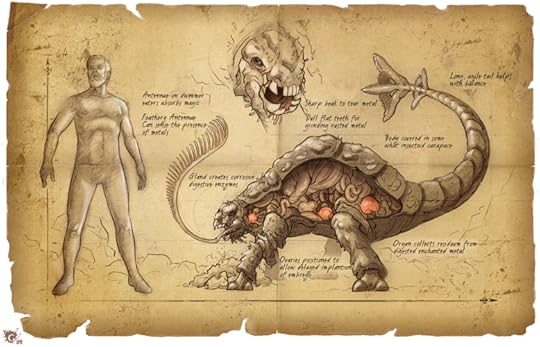 The Rust Monster is an untrainable aberration in Neverwinter Nights, and yet it’s more reasonable than some clients.
The Rust Monster is an untrainable aberration in Neverwinter Nights, and yet it’s more reasonable than some clients.Today, we aren’t faring any better than we started. What we’re doing doesn’t work, the construction industry continues to face significant inefficiencies and waste, impacting both its economic performance and environmental footprint. Global construction waste is projected to reach 2.2 billion tons annually by this year, 2025, nearly double the volume from a decade ago. It didn’t stop nor relented (see here). In the United States alone, construction and demolition waste exceeded 600 million tons in 2018, a 342% increase since 1990, and over 75% of this waste is not recycled (see here). Construction waste is a challenge for over 95% of ongoing projects, but only about 57% of companies track or measure it (see here).
And what about the quality of work? Don’t make me laugh. The construction industry has been facing a mental health crisis way before the pandemic surge, with workers experiencing some of the highest rates of mental health issues and suicide compared to any other sector. Suicide rates among construction workers are nearly four times higher than the general population, as I was writing here a while ago, more than 50% of builders in the UK reported struggling with mental health problems during 2023, and nearly 1 in 5 construction workers report having anxiety or depression in the US, while 84% of those affected did not seek professional help (see here and here).
While some of these issues, such as waste and environmental impact, have been included in BIM’s promise to improve them, others have never even been on the table.
Despite our best or worst efforts, BIM risks becoming less a weapon of change and more a relic displayed in the halls of “we meant well.”
If we are to continue this quest of digitalisation with integrity, perhaps it’s time to pause, sharpen our tools, and — most importantly — remember why we picked them up in the first place.
1.2. The Myth of BIM as a Universal SolutionBack at the dawn of BIM’s mythic era, the promise was simple yet radical:
Stop drawing lines. Start managing information.
Early BIM wasn’t about spinning 3d models like a digital Vitruvian Man; it was about creating a structured, coherent environment where data travelled with the project, from inception to construction, from maintenance to eventual reuse.
In its purest form, BIM offered:
a single source of truth through the wise understanding and application of the Common Data Environment;objects enriched with attributes (not just sofas modelled down to the woven fabric and upholstered leather);a profound shift from artefact-making to knowledge-building. Yeah, I know
Yeah, I knowThis was no trivial upgrade from the simple drafting of drawings to illustrate the design, building and operational idea behind a system. It was the architectural equivalent of discovering that a building could think for itself — if only we were wise enough to ask it the right questions. The ambition wasn’t merely better drawings; it was better buildings, better decisions, better outcomes. BIM, in its original spirit, was a call to intelligence through design — and like all noble quests, it demanded more than technical skill: it demanded vision.
 And we all know how that ended.
And we all know how that ended.Of course, no hero’s journey is complete without a little hybris. Somewhere along the way, the industry mistook the map for the territory, the model for the mission. BIM became a buzzword. A badge of honor. A line item on a tender. Software vendors sold it as a silver bullet. Marketing departments wrapped it in glossy reports promising 20% savings here, 15% efficiency gains there — as if a new tool alone could undo decades of systemic fragmentation.
Suddenly, BIM was expected to fix everything:
Bad project management? BIM it!Poor communication? BIM it!Unclear client briefs? Surely a model will sort that out!BIM was intended to amplify good practice, not conjure it out of thin air.
 We did try to tell the industry, to be fair: there’s no BIM without quality, project and asset management. Maybe a picture alone wasn’t going to cut it.
We did try to tell the industry, to be fair: there’s no BIM without quality, project and asset management. Maybe a picture alone wasn’t going to cut it.This myth of BIM as a universal cure-all is doing more than inflate expectations: it’s going to corrode trust. When BIM implementations fail — not because the idea is wrong, but because the expectations are fantastical — the backlash will be inevitable. When clients start opening models that are inflated with attributes no one really needs, the blue doughnut they will get in response will be a thunderous answer to the question: “Was this worth all that money?”
That’s why I think this is one of our last chances to reflect, really reflect on what we’re doing with BIM. We stand at a critical juncture. The landscape around us is shifting faster than a river breaking its banks, with more buzzwords being added to the mix (from Digital Twins to Artificial Intelligence). Societal pressures — from climate resilience to ethical construction — demand that we stop digitising nonsense and start building with purpose, and pulling us (willing or not) into new expectations of accountability, traceability, and transparency.
2. The Misinterpretations and MisapplicationsIn short: we are being called not just to use technology, but to think digitally. To reflect, recalibrate, and reforge the tools of digitalisation — so they serve needs, not trends. Our journey must move beyond the myths. It’s time to rebuild the promise — one informed, critical, and purposeful step at a time.
So, where are we doing wrong and what can we do to improve? I don’t have a finite answer, of course, I wouldn’t be here if I did, but I do have a couple of ideas when it comes to the traps and false allies we met during our road to BIM, the shiny baubles that promised shortcuts but led people straight into the swamp: standardization without understanding and compliance without thinking.
These misinterpretations didn’t come waving red flags and twirling villainous moustaches.
 They did not look like that. You can’t dress that fashionably in the construction industry.
They did not look like that. You can’t dress that fashionably in the construction industry.They appeared respectable — even wise — whispering tales of efficiency, best practices, and “the way things must be done.” And maybe they even meant well. I mean, standardization and compliance aren’t bad things per se, you’ll never hear me saying that.
2.1. Standardisation Without UnderstandingAnd yet…
Once upon a time, the arrival of standards like ISO 19650 was hailed as the beginning of a golden age. At last, the wayward tribes of construction and design would march to the same beat! There would be order! Clarity! Harmony! The local, underdeveloped regulations would all align with the same Universal Standard!
Or so the legend went.
In practice, many mistook the existence of standards for the completion of understanding, thought they could disconnect the brain and just follow standards, and were disappointed when they opened the pages and… found none.
This is where things get weird.
Since people wanted tables they could copy and paste into their BIM execution plans, a sort of Mandela Effect took over the construction industry. Forms were filled, naming conventions observed, CDEs dutifully structured with neatly labeled (and entirely meaningless) folders. None of which was part of any norm.
 The Mandela effect is that phenomenon in which everybody believes the same thing that isn’t true, like Pikachu’s tail having a black tip, or people hero and equality champion Nelson Mandela having died in the 80s.
The Mandela effect is that phenomenon in which everybody believes the same thing that isn’t true, like Pikachu’s tail having a black tip, or people hero and equality champion Nelson Mandela having died in the 80s.I mean, if you take a close look at ISO 19650, all you’ll find when it comes to naming conventions is… the necessity of having one. All you’ll find when it comes to Levels of Development and Levels of Information Need (two different things, but that’s a conversation for later) is the need to agree upon an incremental structure of information, geometry and — for the more enlightened — documentation. That’s it.
And yet, we all know what the “correct naming convention” is, right?
Kids, repeat after me.
 C’est n’est pas une file name… these are metadata
C’est n’est pas une file name… these are metadataAnd yet, we all know what the “correct folder structure” for a CDE is, right?
Kids, repeat after me.
 C’est n’est pas une folder structure… this is a workflow scheme
C’est n’est pas une folder structure… this is a workflow schemeIt’s no surprise that the most popular part of the Italian norm on BIM (a National Annexe to ISO 19650 and yet developed before the international norm saw the light) it’s the appendix to part 4 on Levels of Development, which is — and I quote literally — just a bunch of examples. The second-most popular part is part 6, a template on the Exchange Information Requirements, which is… not even a norm: it’s a technical report, specifically meant as a guideline. People want the truth. People want stuff they can copy. People don’t want to think. The heroic flaw here? Mistaking the ritual for the meaning.
Standards were meant as scaffolds, not straightjackets. They offered principles to adapt, not scripts to recite. And yet organisations treat standards like sacred scrolls — to be obeyed without context, questioning, or adaptation to real project needs.
We aren’t trying to summon Baal, for fuck’s sake, that you’re repeating the introduction to ISO 19650-2 as a mantra: the power of standards lays in shared intent, not identical execution.
 Stop calling: he’s not coming.
Stop calling: he’s not coming.In other words, the industry is trading critical thinking for procedural security. They believe the journey can be completed by following the footprints of others — without realising that every project, every client, every challenge demanded its own path, albeit marked with the compass of shared wisdom. A map is useful, by all means, but only if you still know how to navigate.
2.2. Blind Compliance to Non-Existent ManualsIf standardisation without understanding is a false ally, blind compliance with non-existent manuals and standards such as THE naming convention, THE Level of Development Matrix, THE Clash Detection workflow, is a full-blown hallucination. The combination of dozens of little Mandela Effects when it comes to standards have generated one of the more curious phenomena of the BIM era — the belief that somewhere, out there, hidden in an illuminated manuscript or buried deep in a forgotten ISO annex, exists a complete, step-by-step guide to the perfect digital project.
The thinking goes like this:
If we just follow the checklist;If we just use the template;If we just submit the right files in the right folders……then surely, surely BIM will be easy.
 What if Magneto becomes the new host for the Dark Phoenix?
What if Magneto becomes the new host for the Dark Phoenix?This is the fantasy of automation without standardisation, that follows standardisation without thought, just like hell follows Pale Rider in the Apocalypse. It is not good. It is the mirage that tempts to believe the journey can be completed without courage, judgment, or leadership.
But here’s the uncomfortable truth: no manual exists that can replace understanding. And I should know, since I write manuals.
There is no form that can substitute for listening.
No standard can tell you what your client actually needs, or what your project uniquely demands.
Blind compliance, in the end, is not a show of professionalism — it is a surrender. A quiet abdication of responsibility.
Managers, real ones, do not merely tick boxes.
They engage.
They challenge.
They adapt.
They know that the project journey is uncertain, and that the strength to make wise decisions in the unknown is the real skill.
3. Redefining Quality in the Digital EraSo, we’ve come to the uncomfortable realisation: the treasure we were seeking with BIM had to be gained through was a better understanding of our processes.
In the noisy world of digitalisation — where every new platform promises salvation and every new acronym demands allegiance — it’s easy to forget what we are actually here to do: solve real problems, fulfil real needs, create real value.
Instead of creating real problems, for instance.
If BIM is to mean anything at all, we must reclaim an ancient but stubbornly powerful idea: quality is not the perfection of a model, but the fitness of a thing for its purpose.
 A golden and bejewelled toilet brush is considered a quality object only if it’s still able to clean the fucking toilet. And yes, this is the only picture I generated with AI because it thankfully doesn’t exist.3.1. Quality as the Fulfilment of Needs
A golden and bejewelled toilet brush is considered a quality object only if it’s still able to clean the fucking toilet. And yes, this is the only picture I generated with AI because it thankfully doesn’t exist.3.1. Quality as the Fulfilment of NeedsQuality is not an ornamental flourish. It is not “extra.” It is not “when there’s time.” It is the measure of whether what we deliver actually matters.
A drawing that hangs at the Biennale but confuses a contractor? Useless.
A federated model that ticks every Level of Development box but answers no operational question? Noise.
A perfectly structured data drop that no one can use? Decoration.
In the digital age, quality is simple (but not easy):
identify the true need;address it meaningfully;deliver data in a way that creates clarity, not confusion.And here’s the thing: clients don’t always know what they need. Not at first. And it’s often not their job to come preloaded with the right specifications.
It’s our role — our obligation — to help them find it. To move from “What file format would you like?” to “What decision are you trying to make?”
3.2. Process Quality vs Product QualityIn other words: we shouldn’t be suppliers of models. We should be architects of understanding.
How do we do that? Well, for starters we could try taking our head out of our buttocks and stop looking at out stuff like Pygmalion looked at his marble blocks. Too often, the digitalisation conversation gets hijacked by shiny outputs. Look at our 5D model! Marvel at our laser scans! Gasp at our immersive AR visualisations!
Who cares.
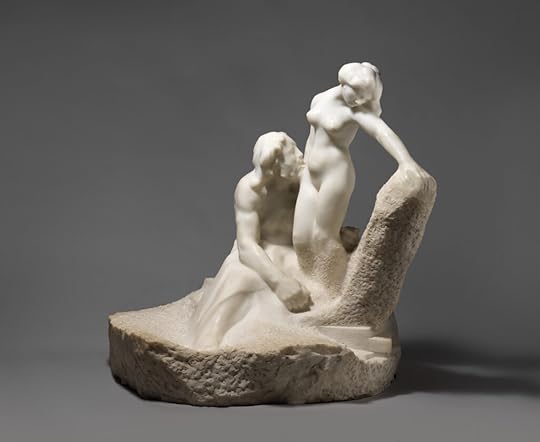 This guy loved his statues so much, Aphrodite granted his wish, but do you really want to marry your Revit models? ’cause I don’t.
This guy loved his statues so much, Aphrodite granted his wish, but do you really want to marry your Revit models? ’cause I don’t.Process Quality is about how decisions are made, how information flows, how clarity is built over time. Product Quality is about the final deliverable, but it is inseparable from the journey that created it. How can we craft meaningful products if stakeholders are digitally inept and people crafting the products aren’t sitting at the tables where decisions are made?
An immaculate model created through months of confusion, misaligned goals, and rework is a Pyrrhic victory (a.k.a. a victory that comes at such a high cost that it’s essentially a defeat). A modest drawing set that arrives when needed, answers the right questions, and leads to sound decisions, on the other hand, might be a triumph. Sure, you didn’t do 4d and 5d, you just used the model to extract drawings, you’ll never get invited to speak at a conference, but guess what? Maybe the client will call you again because what you did actually held value.
The key is deciding the output not based on what we think we should do in order to “be BIM”, but based on an actual assessment of what the client really needs. In the digital world, process is product. There is no meaningful output without meaningful engagement.
Thus, cultivating good processes — transparent, collaborative, purposeful — is not ancillary to digitalisation.
It is digitalisation.
When we arrive at the data drop with our shiny digital models, clients are grappling with bigger, murkier questions:
What are we trying to achieve with this asset?How will we operate it?How can we reduce risk, cost, and environmental impact?If your client is a construction company, questions are even more pressing:
How can we save money and actually deliver the same solution?Can this thing even be built?Can we do it in time?The last thing they need is more files: they need better conversations. The heroic task is not to stand at the gates of the Common Data Environment, launching transmittals with a trebuchet. It is to walk alongside the stakeholders, use the information within the models to illuminate the landscape, and help shape the right questions.
Sometimes this means slowing down the rush to model. Other times, it means admitting that the best solution isn’t a 500TB federated marvel modelled down to the last standing screw but a well-structured schedule and a conversation with the right stakeholders. Often, it means challenging the brief and passing as the troublemaker. Trust me. I know. As we’re witnessing with genAI, clients think they need a magic machine that does what they ask it to do, no questions asked and no objections made.
 Lo and behold! The BIM-o-matic! Yeah, no, that’s not how it works.
Lo and behold! The BIM-o-matic! Yeah, no, that’s not how it works.To guide a client, in this sense, is to accept a heavier burden: responsibility for outcomes, not just deliverables. And that — not the fancy software, not the buzzword compliance, not the glittering acronyms — is the real hallmark of digital mastery.
4. Towards a New Culture of PracticeHere comes the real work: rebuilding not just what we do, but how we think.
The truth is, digitalisation doesn’t need more tools. It needs a new culture — one that privileges purpose over process, meaning over compliance, wisdom over trend-chasing. And every professional in the BIM piramid, regardless of their shiny certification, needs to move from tool-bearers to strategists. Even if their job is to place labels on a 2d drawings. To move from checklist-tickers to framers of meaning. Even if their job is churning models through an automatic tool for validation. To move from passive recipients of standards to active shapers of quality.
The journey forward demands not just better deliverables, but a different way of practising altogether.
How? I can think of three ways.
4.1. Strategic Digitalisation: Purpose Over ToolsTools are seductive. They gleam, they promise shortcuts, they offer the sweet illusion that if we just buy the right thing, mastery will follow. And they don’t talk back.
 Except Dynamo, of course. Dynamo talks back.
Except Dynamo, of course. Dynamo talks back.Strategic digitalisation means asking harder — and better — questions:
What problem are we trying to solve?What knowledge do we need to make the next decision?What outcome matters most?Sometimes the answer will involve a cutting-edge platform.
Sometimes it will involve a spreadsheet and a well-run meeting.
We aren’t medieval knights in the Arthurian cycle, for fuck sake, and we shouldn’t fetishize our weapons.
 Dude. It’s a nice sword, alright, but you’re being weird.
Dude. It’s a nice sword, alright, but you’re being weird.Digital maturity means starting with purpose, not technology. It is not about what we can model or whether it’s technologically possible. It is about why we should model it in the first place.
Educating Clients, Not Just Meeting RequirementsThe ancient compact between client and professional has always been more than transactional. It is a partnership. A mutual journey into the unknown. Yet in the world of digital deliverables, that partnership has frayed.
Too often, clients are asked what outputs they want — not what problems they hope to solve.
Meeting requirements is the easy path.
Educating clients — guiding them towards better questions, clearer goals, more strategic use of information — is the road we need to pursue.
It means:
Challenging briefs that don’t make sense;Refusing to overdeliver irrelevant data just because “the standard says so.” Fuck the standard. It often doesn’t even say so.Helping clients see that digital models are not ornaments, but decision engines.We are not mercenaries: we are mentors. We are not here to dazzle with artefacts but to build capacity, courage, and clarity. True digital transformation does not happen when the model is delivered. It happens when clients become better thinkers about their own assets, their own futures.
 The Lady emerges from her lake, delivers Excalibur, issues her invoice, and we never see her again. It’s Merlin who sticks around, and it’s Merlin we remember.The Role of Norms: Guidance, Not Gospel
The Lady emerges from her lake, delivers Excalibur, issues her invoice, and we never see her again. It’s Merlin who sticks around, and it’s Merlin we remember.The Role of Norms: Guidance, Not GospelFinally, a word about standards, those ancient tomes that many worship more devoutly than any god.
Standards are useful.
They give shape to complexity.
They provide a common language across sprawling, chaotic projects.
I love standards.
But they are not gospel. They were not carved in stone tablets and handed down from Mount BIM. I swear. I was there.
Standards are living frameworks, meant to be interpreted, adapted, and — when necessary — challenged.
A standard is not an excuse to turn off your brain.It is not a shield against poor decisions.It is not an oracle that can tell you what matters for your project, today, with these people.Kids, repeat after me.
The mature practice of digitalisation means wielding standards like a skilled navigator wields a map: not blindly following every marked path, but using it to make better decisions when the terrain gets rough. In the end, standards are only as valuable as the wisdom with which we apply them.
The new culture of practice must embrace flexibility, criticality, and above all: a relentless loyalty to outcomes over appearances.
6. A Call for Thoughtful DigitalisationIf you pardon me for carrying through with the fantasy metaphor — I am replaying Elder’s Scroll IV after all — the hero’s journey doesn’t end with slaying one daedric prince. It ends with the understanding that more Daedra will come — and that the real treasure is knowing how to face them with courage and wisdom.
 This is a Daedric Prince. He is not friendly.
This is a Daedric Prince. He is not friendly.Today, BIM is not the only digital promise shimmering on the horizon: the banners of Digital Twin technologies flutter proudly (and more so in Rome, apparently), the siren songs of Artificial Intelligence grow louder with every passing month, and don’t get me started with Virtual and Augmented Reality, which keep coming back like a hydra you’re killing wrong.
Each comes, as BIM once did, with bold claims.
Seamless integration! Total predictive control! Self-optimizing assets! Effortless intelligence!
And if we have learned anything on this long road, it is this: no technology, no matter how powerful, absolves us from the work of thinking.
Digital Twins will not inherently deliver better outcomes. If we load them with bad data, unclear objectives, or irrelevant KPIs, they will become bloated reflections of our own confusion — expensive mirrors showing us what we refuse to confront.
Artificial Intelligence will not solve our coordination problems. If we train models on biased, incomplete, or irrelevant information, they will reproduce and automate mediocrity — faster and at greater scale than ever before.
The principle remains the same, no matter the tool:
start with needs, not features, and build processes before building artefacts;guide clients toward clarity, not toward dependency;treat standards as guides for meaning, not as shields against thinking.The landscape may be shifting, but the our burden — and privilege — remains constant: act with discernment, choose wisdom over expedience, shape technology around needs, not the other way around. Because if we are not careful, we will once again mistake the tools for the journey, the maps for the land, the buzzwords for the work.
The call to thoughtful digitalisation is not a retreat from innovation. It is an act of defiance. If we are thoughtful and rebellious enough — if we walk this path with clear eyes and ready minds — we have the chance to build something truly remarkable: a digital practice rooted not in fashion but in purpose, a future where technology amplifies wisdom and doesn’t replace it, a profession that does not chase trends, but crafts meaning.
And that, in the end, is the only future worth fighting for.
Something to ReadTo re-read with different eyes:Eastman, C. (2011). BIM handbook : a guide to building information modeling for owners, managers, engineers and contractors. John Wiley And Sons Inc.Succar, B. (2009). “Building information modelling framework: A research and delivery foundation for industry stakeholders”. Automation in Construction, 18(3), 357–375.Deming, W. E. (2000). Out of the Crisis. MIT Press.Further Readings:Munir M, Kiviniemi A, Jones SW, Finnegan S (2012). “BIM business value generation theory: a grounded theory approach”. Journal of Information Technology in Construction (ITcon), Vol. 24, pg. 406-423.Senge, P. M. (2006). The fifth discipline: The art and practice of the learning organization. Random House Business. (Original work published 1990)Floridi, L. (2014). The Fourth Revolution: How the Infosphere is Reshaping Human Reality. Oxford University Press.Taleb, N. N. (2013). Antifragile: Things That Gain from Disorder. Belles Lettres.The picture in the header is John William Waterhouse’s Consulting the Oracle (1884).
April 25, 2025
Today we celebrate
Today Italy celebrates 80 years since the Nazi occupation and their fellows, the local fascists, were kicked out of Milan and Turin, the last two major cities still being held in their blood-soaked grip. The civil war would carry on for another week, but today’s the official holiday. Our local government (a far-right one, in case you missed this detail) invited the country to celebrate “with sobriety” and many cities cancelled the decennial tradition of public gatherings and commemorative parades, which is troubling to say the least. So here’s my invitation to celebrate with enthusiasm. Freedom doesn’t come cheap. Freedom doesn’t come for free.
In the header, a detail of a painting by Renato Guttuso, our local Picasso, who painted against fascism and joined the resistance in 1940.
April 23, 2025
Werewolves Wednesday: The Wolf-Leader (9)
A werewolf story by Alexandre Dumas père.
Chapter IX: The Wolf-LeaderThibault, fleeing from Madame Polet’s threats and her farm servants’ weapons, turned instinctively towards the forest, thinking to take shelter within it should he chance to come across one of the enemy, for he knew that no one would venture to follow him there for fear of any lurking dangers. Not that Thibault had much to fear, whatever kind of enemy he met, now that he was armed with the diabolical power he had received from the wolf. He had only to send them where he had sent the widow’s pig, and he was sure of being rid of them. Nevertheless, conscious of a certain tightening of the heart when from time to time the thought of Marcotte came back to him, he acknowledged to himself that, however anxious to be rid of them, one could not send men to the devil quite as readily as one sent pigs.
While thus reflecting on the terrible power he possessed, and looking back at intervals to see if there were any immediate need to put it into use, Thibault, by the time night fell, had reached the rear of Pisseleu. It was an autumn night, dark and stormy, with a wind that tore the yellowing leaves from the trees, and wandered through the forest ways with melancholy sighs and meanings.
These funereal voices of the wind were interrupted from time to time by the hooting of the owls, which sounded like the cries of lost travelers hailing one another. But all these sounds were familiar to Thibault and made very little impression upon him. Moreover, he had taken the precaution, on first entering the forest, of cutting a stick, four feet long, from a chestnut tree, and, adept as he was with the quarterstaff, he was ready, armed thus, to withstand the attack of any four men. So he entered the forest with all boldness of heart at the spot which is known to this day as the Wolfs’ Heath. He had been walking for some minutes along a dark and narrow glade, cursing as he went the foolish whims of women who, for no reason whatever, preferred a weak and timid child to a brave, strong, full-grown man, when all of a sudden, at some few paces behind him, he heard a crackling among the leaves. He turned and the first thing he could distinguish in the darkness was the glowing light in a pair of eyes which shone like live coals. Then, looking more closely, and forcing his eyes, so to speak, to penetrate the gloom, he saw that a great wolf was following him, step by step. But it was not the wolf that he had entertained in his hut; that was black, while this was a reddish-brown. There was no mistaking one for the other, either as to colour or size. As Thibault had no reason to suppose that all the wolves he came across would be animated with such benevolent feelings towards him as the first with which he had had dealings, he grasped his quarter-staff in both hands, and began twirling it about to make sure he had not forgotten the knack of using it. But to his great surprise the wolf went on trotting quietly behind him, without evincing any hostile intention, pausing when he paused, and going on again when he did, only now and then giving a howl as if to summon re-inforcements. Thibault was not altogether without uneasiness as regards these occasional howls, and presently he became aware of two other bright spots of light in front of him, shining at intervals through the darkness which was growing thicker and thicker. Holding his stick up in readiness to hit, he went forward towards these two lights, which remained station ary, and as he did so, his foot seemed to stumble against something lying across the path it was another wolf. Not pausing to reflect whether it might not be unwise now to attack the first wolf, Thibault brought down his staff, giving the fellow a violent blow on the head. The animal uttered a howl of pain, then shaking his ears like a dog that has been beaten by its master, began walking on in front of the shoemaker. Thibault then turned to see what had become of the first wolf: it was still following him, still keeping step with him. Bringing his eyes back again to the front, he now perceived that a third wolf was walking alongside to the right, and turning instinctively to the left, saw a fourth flanking him on that side too. Before he had gone a mile, a dozen of the animals had formed a circle round him. The situation was critical, and Thibault was fully conscious of its gravity. At first he tried to sing, hoping that the sound of the human voice might frighten away the animals; but the expedient was vain. Not a single animal swerved from its place in the circle, which was as exactly formed as if drawn with compasses. Then he thought he would climb up into the first thick-leaved tree he came to, and there wait for daylight; but on further deliberation, he decided that the wisest course was to try to get home, as the wolves, in spite of their number, still appeared as well intentioned as when there was only one. It would be time enough to climb up into a tree when they began to show signs of any change of behaviour towards him.
At the same time, we are bound to add that Thibault was so disquieted in mind and had reached his own door before he knew where he was that he did not at first recognize his own house. But a still greater surprise awaited him, for the wolves in front now respectfully drew back into two lines, sitting up on their hind legs and making a lane for him to pass through. Thibault did not waste time stopping to thank them for this act of courtesy but dashed into the house, banging the door shut behind him. Having firmly shut and bolted the door, he pushed the great chest against it to better resist any assault that might be made upon it. Then he flung himself into a chair and at last began to find himself able to breathe more freely.
As soon as he was somewhat recovered, he went and peeped through the little window that looked out on the forest. A row of gleaming eyes assured him that far from having retired, the wolves had arranged themselves symmetrically in file in front of his dwelling.
To anyone else the mere proximity of the animals would have been most alarming, but, Thibault who shortly before, had been obliged to walk escorted by this terrible troop, found comfort in the thought that a wall, however thin, now separated him from his formidable companions.
Thibault lit his little iron lamp and put it on the table; drew the scattered wood-ashes of his hearth together and threw on them a bundle of chips, and then made a good fire, hoping that the reflection of the blaze would frighten away the wolves. But Thibault’s wolves were evidently wolves of a special sort, accustomed to fire, for they did not budge an inch from the post they had taken up. The state of uneasiness he was in prevented Thibault from sleeping, and directly dawn broke, he was able to look out and count them. They seemed, just as on the night before, to be waiting, some seated, some lying down, others sleeping or walking up and down like sentinels. But at length, as the last star melted away, drowned in the waves of purple light ebbing up from the east, all the wolves with one accord rose, and uttering the mournful howl with which animals of darkness are wont to salute the day, they dispersed in various directions and disappeared. Thibault was now able to sit down and think over the misadventure of the previous day, and he began by asking himself how it was that the mistress of the Mill had not preferred him to his cousin Landry. Was he no longer the handsome Thibault, or had some disadvantageous change come over his personal appearance? There was only one way of ascertaining whether this was so or not, namely, by consulting his mirror. So he took down the fragment of looking-glass hanging over the chimney-piece, and carried it towards the light, smiling to himself the while like a vain woman. But he had hardly given the first glance at himself in the mirror, before he uttered a cry, half of astonishment, half of horror. True, he was still the handsome Thibault, but the one red hair, thanks to the hasty wishes which had so imprudently escaped him, had now grown to a regular lock of hair, of colour and brilliancy that vied with the brightest flames upon his hearth.
His forehead grew cold with sweat. Knowing, however, that all attempts to pluck it out or cut it off would be futile, he made up his mind to make the best of the matter as it stood, and in future to forbear as far as possible from framing any wishes. The best thing was to put out of his mind all the ambitious desires that had worked so fatally for him, and go back to his humble trade. So Thibault sat down and tried to work, but he had no heart for the job. In vain he tried to remember the carols he had been in the habit of singing in the happier days when the beech and the birch shaped themselves so quickly beneath his fingers; his tools lay untouched for hours together. He pondered over matters, asking himself whether it was not a miserable thing to be sweating one’s heart out merely for the privilege of leading a painful and wretched existence, when, by judiciously directing one’s wishes one might so easily attain to happiness. Formerly, even the preparation of his frugal meal had been an agreeable distraction, but it was so no longer; when hunger seized him and he was forced to eat his piece of black bread, he did it with a feeling of repugnance, and the envy, which had hitherto been nothing more than a vague aspiration after ease and comfort, was now developed into a blind and violent hatred towards his fellow creatures.
Still the day, long as it seemed to Thibault, passed away like all its fellows. When twilight fell, he went outside and sat down on the bench which he had made himself and placed in front of the door, and there he remained, lost in gloomy reflections. Scarcely had the shadows be gun to darken, before a wolf emerged from the underwood, and, as on the previous evening, went and lay down at a short distance from the house. As on the evening before, this wolf was followed by a second, by a third, in short by the whole pack, and once more they all took up their respective posts preparatory to the night’s watch. As soon as Thibault saw the third wolf appear, he went indoors and barricaded himself in as carefully as the evening before; but this evening he was even more unhappy and low spirited, and felt that he had not the strength to keep awake all night. So he lighted his fire, and piled it up in such a way that it would last till the morning, and throwing himself on his bed, fell fast asleep. When he awoke, it was broad daylight, the sun having risen some hours before. Its rays fell in many colours on the quivering autumn leaves, dyeing them with a thousand shades of gold and purple.
Thibault ran to the window, the wolves had disappeared, leaving behind only the mark of where their bodies had lain on the dew-covered grass.
Next evening they again congregated before his dwelling; but he was now growing gradually accustomed to their presence, and had come to the conclusion that his relations with the large black wolf had somehow awakened sympathetic feelings towards him in all other individuals of the same species, and he determined to find out, once for all, what their designs towards him really were. Accordingly, thrusting a freshly sharpened bill-hook into his belt, and taking his boar-spear in his hand, the shoemaker opened his door and walked resolutely out to face them. Having half expected that they would spring upon him, he was greatly surprised to see them begin to wag their tails like so many dogs on seeing their master approach. Their greetings were so
expressive of friendliness, that Thibault even ventured to stroke one or two of them on the back, which they not only allowed him to do, but actually gave signs of the greatest pleasure at being thus noticed.
“Oh! ho!” muttered Thibault, whose wandering imagination always went ahead at a gallop, “if these queer friends of mine are as obedient as they are gentle, why, here I am, the owner of a pack unequalled by any my Lord Baron has ever possessed, and I shall have no difficulty whatever now in dining on venison whenever the fancy so takes me.”
He had hardly said the words, when four of the strongest and most alert of the four-footed beasts separated themselves from the others and galloped off into the forest. A few minutes later a howl was heard, sounding from the depths of the underwood, and half an hour afterwards one of the wolves reappeared dragging with it a fine kid which left behind it a long trail of blood on the grass. The wolf laid the animal at Thibault’s feet, who delighted beyond measure at seeing his wishes, not only accomplished, but forestalled, broke up the kid, giving each of the wolves an equal share, and keeping the back and haunches for himself. Then with the gesture of an Emperor, which showed that he now at last understood the position he held, he ordered the wolves away until the morrow.
Early next morning, before the day broke, he went off to Villers-Cotterets, and at the price of a couple of crowns, the Innkeeper of the Boule-d’Or, took the two haunches off his hands.
The following day, it was half of a boar that Thibault conveyed to the Innkeeper, and it was not long before he became the latter’s chief purveyor.
Thibault, taking a taste for this sort of business, now passed his whole day hanging about the taverns, and gave no more thought to the making of shoes. One or two of his acquaintances began to make fun of his red lock, for however assiduously he covered it with the rest of his hair, it always found a way of getting through the curls that hid it, and making itself visible. But Thibault soon gave it plainly to be understood that he would take no joking about the unfortunate disfigurement.
Meanwhile, as ill luck would have it, the Duke of Orleans and Madame de Montesson came to spend a few days at Villers-Cotterets. This was a fresh incentive to Thibault’s madly ambitious spirit. All the fine and beautiful ladies and all the gay young lords from the neighbouring estates, the Montbretons, the Montesquious, the Courvals, hastened to Villers-Cotterets. The ladies brought their richest attire, the young lords their most elegant costumes. The Baron’s hunting-horn resounded through the forest louder and gayer than ever. Graceful amazons and dashing cavaliers, in red coats laced with gold, passed like radiant visions, as they were borne along on their magnificent English horses, illuminating the sombre depths of the wood like brilliant flashes of light.
In the evening it was different; then all this aristocratic company assembled for feasting and dancing, or at other times drove out in beautiful gilt carriages bedizened with coats of arms of every colour.
Thibault always took his stand in the front rank of the lookers-on, gazing with avidity on these clouds of satin and lace, which lifted now and then to disclose the delicate ankles encased in their fine silk stockings, and the little shoes with their red heels. Thus the whole cavalcade swept past in front of the astonished peasantry, leaving a faint exhalation of scent and powder and delicate perfumes. And then Thibault would ask himself why he was not one of those young lords in their embroidered coats; why he had not one of these beautiful women in their rustling satins for his mistress. Then his thoughts would turn to Agnelette and Madame Polet, and he saw them just as they were, the one a poor little peasant girl, the other nothing more than the owner of a rustic mill.
But it was when he was walking home at night through the forest, accompanied by his pack of wolves, which, from the moment the night fell and he set foot inside the forest, no more thought of leaving him than the King’s bodyguard would dream of leaving their Royal master, that his broodings took their most disastrous turn. Surrounded by the temptations which now assailed him, it was only what was to be expected that Thibault who had already gone so far in the direction of evil, should break away from what little good was still left in him, losing even the very remembrance of having once led an honest life. What were the few paltry crowns that the Land lord of the Boule-d’Or gave him in payment for the game which his good friends the wolves procured for him? Saved up for months, even for years, they would still be insufficient to satisfy a single one of the humblest of the desires which kept tormenting his brain. It would be scarcely safe to say that
Thibault, who had first wished for a haunch of the Baron’s buck, then for Agnelette’s heart, and then for the widow Polet’s mill, would now be satisfied even with the Castle at Oigny or Longpont, to such extravagant issues had his ambition been excited by those dainty feet, those trim ankles, those exquisite scents exhaled from all those velvet and satin gowns.
At last one day he said to himself definitely that it would be the veriest folly to go on living his poor life when a power so tremendous as he now possessed, was at his disposal. From that moment he made up his mind that, no matter if his hair should grow as red as the crown of fire which is seen at night hanging over the great chimney at the glass works of Saint Gobain, he would exercise this power of his to the accomplishing of the most high-flown of his ambitions.
…to be continued.















